Kindergarten Lessons
Involve me and I learn...
Math Teaching/Learning

KINDERGARTEN PROBLEM SOLVING
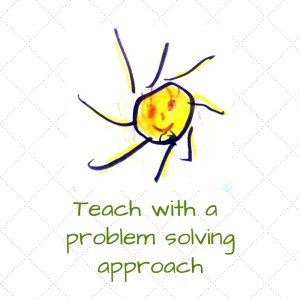
Learning how to approach and solve problems early in life, not only helps children enjoy and look forward to sorting them out, it also helps them make and keep friends.
Preschool and kindergarten problem solving activities give children an opportunity to use skills they have learned previously and give you an opening to teach new problem solving strategies.
Introduce the vocabulary of solving problems with stories, puppets and everyday situations that occur. “We only have 10 apples but there are 20 students. This is a problem . Let’s think of some ways that we can solve this problem ?”
Use terms like, “a different way, let’s brainstorm, that’s a challenge, let’s think of some different solutions”.
How do I develop a problem solving approach?
Asking children questions such as , “How would you…?” or “Show me how you could…?”, help set the stage for teaching with a problem solving approach. Keep problem solving topics about subjects that interest the students. Kids are constantly trying to problem solve as they play.
Students are learning to:
- Identify problems or challenges
- Fact find (what do I know, what have I tried)
- Think of ways to solve the problem (brainstorm, creative thinking, generate ideas)
- Test their ideas
What preschool and kindergarten problem solving strategies can I teach?
Young children need real objects, pictures, diagrams, and models to solve problems. Start with real objects and move slowly to diagrams and pictures. Any of the following problem solving strategies will help them work through the four steps above:
- using objects
- acting the problem out
- looking for patterns
- guessing and checking
- drawing pictures
- making a graph
- teach with projects
Play creates classroom opportunities for problem solving
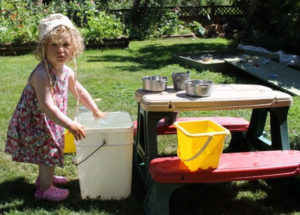
Perhaps a child is getting frustrated as he/she plays with blocks. To help him/her focus on the problem ask questions such as:
- What are you trying to do with your blocks?
- What isn’t working?
- What have you tried?
- Can you think of another way to stack the blocks?
- What else can you try?
Encourage creative thinking
Reinforce creative thinking, not results. The ability to solve problems and think creativity is important.
Talk about the different ways the child tried to solve the problem rather than the outcome. “Joe tried three different ways to stack the blocks. That was a great effort, Joe.”
Social classroom problem solving opportunities are abundant

- Identify the problem – Talk about the problem. For instance, some children may be worried because other kids are hiding the center markers for the play center and giving them to their friends. Other kids are not getting turns.
- Fact find – There are only 4 center markers for the play center because it is small and more than 4 kids would be too crowded. Some kids are hiding them so they can play with the same children each time.
- Brainstorm ideas – How can everyone have turns? What ideas do you have? What could we try?
- Test the idea – Let’s try that idea and meet again tomorrow and see how its working.
Investigating and Problem Solving
Using short periods of time examining and investigating objects, such as feathers or rocks, captures children’s attention and challenges them to inquire, to develop mind sets of being problem solvers and to think independently. Find a sample lesson here…
A Blog About Parenting: Coping Skills, Behavior Management and Special Needs

25 Fun Problem Solving Activities for Kids
Problem-solving activities for kids : Explore 24 fun problem-solving games and activities, and learn effective tips and strategies to teach kids problem-solving skills. If you want to explore problem-solving strategies more in-depth, you can also grab our workbook “ Problem-Solving for Kids ” (printable resource).
Problem-solving is the cognitive process of finding solutions to challenges or complex situations.
A systematic approach to problem-solving tends to include defining the problem, gathering information and data, generating potential solutions, evaluating the pros and cons of each solution, making a decision, and implementing the chosen solution.
Effective problem-solving often requires critical thinking, a good dose of creativity, and the ability to consider multiple perspectives. It may also involve identifying patterns, breaking down a problem into manageable chunks, and applying our logic to develop solutions.
Problem-solving is present in everyday situations and across all fields: business, science, personal life, and education. There is not one single aspect in our lives where we don’t need to apply our problem-solving skills.
Table of Contents
- Problem-solving steps
- Development of problem-solving in childhood
- Benefits of developing problem-solving skills
- 10 Tips to teach kids problem-solving skills
- 10 Examples of problem-solving strategies
- 25 Problem-solving activities and games for kids
Problem-Solving Steps
Some key components of problem-solving include:

- Identifying the problem Recognizing and defining the issue or challenge that needs to be addressed.
- Analyzing the problem Investigating and understanding the underlying causes, factors, and relationships related to the problem.
- Generating solutions Generating potential solutions or strategies to address the problem.
- Evaluating all possible solutions (Pros and Cons Analysis) Assessing the feasibility, effectiveness, and potential consequences of each solution. Considering the positive and negative aspects of each solution.
- Decision-making Selecting the best solution based on our analysis and judgment.
- Implementing the best solution Actioning our chosen solution
- Monitoring progress and results
- Reflecting on the outcomes Reviewing and evaluating the outcomes of the implemented solution, learning from the experience, and making adjustments if necessary.
Development of Problem-Solving Skills in Childhood
Children begin to develop problem-solving skills from a very early age, and these skills continue to develop and refine throughout childhood and adolescence.
Babies soon learn about action and reaction. And, as early as eight months, they begin to acquire an understanding of cause and effect (they shake a rattle, it makes a sound; they push a toy, it falls)
Between 13 and 24 months, they start solving simple problems through trial and error and engage in symbolic play using their imagination.
As children progress into middle childhood (ages 7-11), they develop more advanced problem-solving skills. They become capable of understanding multiple perspectives and can consider multiple factors when solving problems. They start using logic and reasoning to solve increasingly complex problems.
During adolescence (ages 12 and up), problem-solving skills continue to develop. Teenagers can generate and test hypotheses and use deductive and inductive reasoning to arrive at solutions.
Each child will develop their problem-solving skills at their own pace. Some children may show advanced problem-solving abilities at an earlier age. Others may require more time and experience to develop these skills fully.
Benefits of Developing Problem-Solving Skills in Children
Problem-solving skills in children are crucial for children’s cognitive, social, and emotional development. It equips them to approach challenges, think critically, make informed decisions, and find creative solutions.
The benefits of good problem-solving skills in children include:
- Positive impact on self-esteem and confidence Identifying, analyzing, and solving their problems contributes to our kids’ sense of competence .
- Fosters Independence and Autonomy When our kids are able to problem-solve on their own, they take one more step toward independence
- Academic Success Problem-solving skills contribute to academic achievement, as they help students analyze and solve complex problems across various subjects.
- Cognitive Development Problem-solving fosters cognitive skills such as logical reasoning, analytical thinking, and abstract reasoning.
- Critical Thinking Problem-solving enhances critical thinking abilities, enabling children to evaluate information, identify biases, and make informed judgments.
- Creativity Problem-solving promotes creativity by encouraging children to think outside the box, generate innovative ideas, and explore multiple solutions.
- Emotional Resilience Problem-solving skills enhance emotional resilience by enabling children to manage and cope with challenges effectively, reducing stress and promoting well-being.
- Improved Social Interactions/Relationships Problem-solving abilities contribute to better social interactions, conflict resolution , and peer collaboration, promoting healthy relationships.
- Future career success Problem-solving skills are highly valued in the workplace and can positively influence future career success.
10+ Helpful Tips to Teach Kids Problem-Solving Skills
Teaching problem-solving skills to kids is an important part of their cognitive development. It helps them develop critical thinking, creativity, and resilience.
But how can we help our kids and students to develop this essential skill?
We can help our kids and students develop and improve their problem-solving skills in many ways. These are some helpful tips that you could consider:
- Model problem-solving behavior When you see yourself in a problem-solving situation, verbalize your thought process: “I wonder how I should address this issue. I guess my alternatives could be… They all have positives and negatives….”
- Let them participate in the problem-solving situation “Could you help me solve this puzzle?”
- Provide real-life problem-solving situations Real-life scenarios make problem-solving more meaningful for kids. For example, discuss how to resolve a conflict with a sibling or how to make the morning routine smoother.
- Teach them how to break down problems Show them how to break down complex problems into manageable sub-problems.
- Practice brainstorming Create brainstorming situations where all the family (or the classroom) can contribute to solving a problem
- Teach the value of perseverance Sometimes, we must stick to a situation and persevere before finding a solution. Encourage kids to persevere through challenges and setbacks, emphasizing that mistakes and failures are opportunities for learning.
- Encourage critical thinking Encourage kids to analyze situations, consider different perspectives, and evaluate possible outcomes.
- How could we make your school lunch healthier but still yummy?
- How could we reuse/recycle all this paper?
- What could we do to help you remember all the steps in your night routine?
- Encourage reflection When they can find a solution for a problem, don’t jump to solve it for them. Encourage them to reflect on the problem and find and evaluate alternatives. And after a problem is solved, think about the whole process and the learnings. “How did this work?” “What did you learn” “Do you need to change anything?”
- Foster creativity Provide them with opportunities for imaginative play, creative projects, and brainstorming sessions.
- Teach the value of teamwork Teach kids the importance of working together to solve problems. Engage them in group activities or projects that require teamwork and collaboration. This helps kids learn the value of different perspectives and work together towards an objective while they practice their communication skills.
- Teach decision-making skills Teach kids how to approach problems systematically by going through the steps we have mentioned in our first section.
- Encourage both structured and free play. Structured play can help you create good problem-solving situations, while free play will foster creativity.
Developing problem-solving skills is an ongoing process that will also continue in adulthood. Provide your kids with guidance and support, and celebrate their efforts and achievements along the way.

10 Examples of Problem-Solving Strategies
There are different strategies that can help us solve a wide range of problems. Here are some commonly recognized problem-solving strategies:
1 . Trial and Error : This is the first problem strategy that we ever learn. We start using trial and error strategies in infancy, and it continues serving its purpose in many situations. This strategy involves trying different solutions or approaches and learning from the errors or failures until a successful solution is found.
2. Algorithm: An algorithm is a step-by-step procedure or a set of rules that guarantees a solution to a specific problem. It is a systematic approach to problem-solving that follows a predetermined set of instructions.
3. Heuristics: Heuristics are mental shortcuts or rules of thumb that help simplify problem-solving by providing quick and efficient strategies. While heuristics can be effective in many situations, they may also lead to biases and errors.
4. Divide and Conquer: This strategy involves breaking down a complex problem into smaller, more manageable chunks or steps that make the overall problem easier to tackle.
5. Working Backwards: This strategy involves starting from the desired outcome and working backward to determine the steps or actions needed to reach that outcome. We often use this problem-solving strategy when we set goals.
6. Analogical Reasoning: Analogical reasoning involves drawing parallels between the current problem and a similar problem that has been solved in the past. By applying the solution from the previous problem to the current one, individuals can find a solution more efficiently.
7. Brainstorming: Brainstorming gets lots of brains working on the same problem. It is a great collaborative problem-solving strategy that can bring different perspectives and experiences to the table and may result in lots of creative ideas and solutions.
8. Decision Matrix: A decision matrix is a systematic approach to evaluating and comparing different options or solutions. It involves creating a matrix that lists alternatives and the criteria for evaluation. It assigns weights or scores to each criterion to come up with the optimal alternative.
9. Root Cause Analysis: Sometimes, we need to understand what is causing a problem before we can attempt to solve it, as different causes may require different approaches (for example, when you are sick, your doctor may need to understand what is causing the problem before prescribing a medicine)
10. Simulation and Modeling: Simulation involves creating a simplified representation or model of a problem situation to gain insights and test different scenarios.
Our choice of strategy will depend on the problem, available resources, and our own personal preferences and circumstances. We may also need to combine strategies or apply different ones to different aspects of a complex problem.

(Disclosure: We are a participant in the Amazon Services LLC Associates Program, an affiliate advertising program designed to provide a means for us to earn fees by linking to Amazon.com and affiliated sites. You can also read our Disclosure & Disclaimer policy here )
Best Problem-Solving Activities for Kids
Play-based activities are centered around play and are designed to engage children in active learning and exploration. And fun problem-solving activities are a great way to develop children’s critical thinking, creativity, and decision-making skills.
In this section, we will review some problem-solving games and activities that will engage your kids’ critical-thinking skills and creativity.
1. Puzzle Games Puzzles are a fun activity for children of all ages. Young children will enjoy simple puzzles, while older children (and adults!) can have fun with more complex ones. Encourage them to use logical thinking and problem-solving strategies to complete the puzzles.
2. Crosswords A crossword is another fun type of puzzle and a good source of mental stimulation.
3. Sudoku Sudoku is a popular logic-based puzzle that involves filling a grid with numbers.
It can be extremely easy or very challenging, adaptable even for young learners.
Let’s go now for a couple of building challenges!
4. Build the Tallest Tower Give the child a set of materials (Legos, building blocks, wooden blocks, or other construction materials) and ask them to build the tallest tower they can. This simple game will encourage them to problem-solve as they build and figure out how to make the tower stable.
5. Build Towers with Different Materials Ask your child to build three different towers with different materials. Then assess how stable they are and how much weight they can hold. Analyze the pros and cons of using each type of material.
6. Treasure Hunt Set up a treasure hunt with clues leading to hidden objects or rewards. Children will have to follow the clues and solve puzzles to find the ultimate prize. This activity encourages problem-solving, critical thinking, and teamwork.
7. Scavenger Hunt Playing Scavenger Hunt can be a fun way for our kids to put their creative problem-solving skills to good use. Provide them with clues and puzzles that they must solve in order to find the next clue.
8. Mystery Bag Fill a bag with random objects and ask children to come up with creative uses for each item. Encourage them to think outside the box and find innovative solutions.
9. Memory Game While memory games primarily focus on memory retention and recall, they can indirectly contribute to problem-solving skills by developing cognitive abilities such as attention, information processing, and adjusting their strategies.
10. Role-Playing Scenarios Create role-playing scenarios where children have to solve a problem or make decisions. For example, pretend to be stranded on a desert island and ask them to decide what items they will take and how they will survive.
11. Role-Play Social Situations Work in developing social skills with social problem-solving situations.
12. Brainstorming Sessions Choose a topic or problem and hold brainstorming sessions where children can generate as many ideas as possible. Encourage them not to limit themselves (even if alternatives feel unfeasible!)
13. Team Building Activities and Games Engage children in team-building games like building a balloon tower. Each team member will need to collaborate, communicate, and problem-solve together to complete the project.
14. Escape Rooms An escape room is a super fun team problem-solving activity.
In an escape room, participants are locked inside a themed room and must work together to solve puzzles, find clues, and accomplish tasks within a given time limit in order to “escape” from the room.
15. Science Experiments Conduct simple science experiments that involve problem-solving. For example, in the classic “sink or float” experiment, children predict and test which objects will sink or float in water.
Problem-Solving Board Games
There are many board games that will test our kids problems solving activities. These are just a few examples:
16. Cluedo Players must solve a murder mystery by deducing the murderer, the weapon used, and the location of the crime. Players collect and examine clues to eliminate possibilities and make logical deductions.
17. Codenames Another classic game where players are split into two teams and must guess words based on clues from their teammates.
There are many codenames games available, including themes like Disney or Harry Potter.
18. Mastermind Game In this strategy game players take turns setting and solving secret codes
19. Scrabble Scrabble is a classic word game where players form words on a game board using letter tiles.
Kids must use their problem-solving skills to analyze the available letters, consider the best word combination and strategically place those words to score the highest points.
Learning Problem-Solving with Card Games
Card games provide opportunities for kids to develop problem-solving skills such as strategy, memory, pattern recognition, decision-making, and observation.
Just a couple of examples:
20. Uno Uno is a classic card game where kids match cards based on color or number. They need to assess their cards, strategize and make decisions about which cards to play to get rid of their cards while also considering the cards in their opponents’ hands.
21. Go Fish Go Fish is a classic card game where players try to collect sets of cards by asking other players if they have specific cards. Players need to remember which cards they have and make decisions about who to ask and what sets to pursue.
22. Coding Challenges Introduce children to coding activities using platforms like Scratch (or ScratchJr for younger kids), Code.org, or Tynker. Coding involves problem-solving and logical thinking, and children can create interactive stories, games, or animations.
23. Outdoor Problem Solving Take children outside and present them with challenges that require problem-solving, such as building a shelter using natural materials or finding their way through an obstacle course.
24. Problem-Solving Worksheets Help your child follow a systematic approach to problem-solving with these helpful worksheets
25. Goal-Setting Activities for Kids Learning to set goals and make plans to achieve them is also a problem-solving activity. I have several resources to teach kids about goal-setting that I will list below:
- Goal-Setting Activities for Kids
- SMART Goals for Kids
- Goal Tracker Thermometer
Remember to provide guidance and support during these activities while encouraging children to think independently and come up with their own solutions.
Problem-Solving Worksheets

Looking for kid-friendly examples of problem-solving strategies ?
This workbook explores the following problem-solving strategies (with child-friendly examples and activities):
- Trial and Error
- Heuristics (Clever shortcuts)
- Divide and Conquer
- Working Backwards
- Brainstorming
- Decision Matrix
- Root Cause Analysis
- Systematic problem-solving

One Comment
I always look forward to your articles with active interventions. Thank you!
Leave a Reply Cancel reply
Your email address will not be published. Required fields are marked *
- WV App Login
- Site Search
- Report Templates
- Speech Helpers
- SLP Resources
- Top 10 Tips
- Getting an Eval
- Certified SLP
- How to Say the R Sound
- 0-18 Months
- 18-36 Months
- 18-30 Months
- 30-36 Months
- 10-11 Years
- Articulation
- Cleft Palate
- Phonological
- Dysphagia Causes
- Dysphagia Treatment
30 Problem Solving Scenarios for Speech Therapy Practice
As promised here are the words for your unlimited use .
If you know others who can use our lists ...
... please share this page using our site share buttons.
Explore Our Goal Reaching, Client Centered Products

SEE ALSO: Houston We Have a Problem! Activities for Problem Solving
Problem solving scenarios.
- Your friends came over to your house for a movie night. One of your friends brought another friend so there are more people than you planned for. You want to pass out the drinks but you only have five cans of soda and you need 6 for everyone to have one. What could you do?
- After basketball practice you go back to the locker room with your team to shower and change. When you are done dressing, you can't find your shoes. What could you do?
- You have been waiting all day for lunch to come because you are starving. Finally class gets over and you get to go to lunch. Except when you go to get to your lunch, it's not there. You probably left it at home. What could you do?
- There is a guy in your class who is always mean to you. He always bumps you when he walks by and he calls you names. He knocks stuff out of your hands and makes you feel stupid. You don't think you can take it anymore. What could you do?
- You really want to invite this new girl/guy to come to your birthday party, but you have never talked to them before. You are worried they will say no. What could you do?
- You rode the bus to school today and on the way in people are pointing and laughing at you. You go in the bathroom and see that you have pink gum all over the back of your pants. What could you do?
- You wake up and see that your alarm never went off. So you are starting your morning 15 minutes later than you planned. It is a really important day at school and you cannot be late. What could you do?
- You are giving a group presentation in front of class and it's your turn to talk. All of the sudden you sneeze. You cover it with your hand, but now your hand is full of stuff you sneezed out. What could you do?
- You are eating dinner at a fancy restaurant with your parents and their friends. You have a really messy dinner and accidentally flip a noodle into the lady's lap. They are busy talking and don't notice it. What could you do?
- You are taking a test and there is no talking allowed. You are writing your answers on the paper and your pencil breaks. What could you do?
- You are taking a test and the guy behind you asks you for help. He wants to know what you put for question number two. What could you do?
- You are at a birthday party and you have waited in line for a long time for your turn to hit the pinata. It is finally going to be your turn and it looks like the next hit will break the pinata. But you suddenly have to go to the bathroom. What could you do?
- You are hanging outside with your friend and she decides to pick your neighbor's flowers. She gives you the pretty handful of flowers and right then your neighbor opens the door. She asks you why you picked her flowers. What could you do?
- You borrowed your sister's skates one day without asking and they broke while you were using them. What could you do?
- You are eating at a friend's house and the mom piles your plate full of food. It looks really good and you want to eat it all but you can't because you just ate a snack. What could you do so you don't hurt her feelings?
SEE ALSO: The Best Free App for Speech Therapy

- Your teacher was working at her desk. You wanted to ask her a question, but she didn't see your hand raised. What should you do?
- You started to do your work, but you weren't sure if you were doing it right. What should you do?
- You were playing tether-ball and were the champion so far. In the next game, you slightly touched the rope. Only one student saw you touch the rope. What will you do?
- The teacher is giving directions, but your friend sitting next to you keeps talking. You can't hear the directions. What should you do?
- You didn't do your homework. Your teacher was upset with you. What should you do?
- You finished eating and felt a burp coming. What are you going to do?
- You were waiting to swing. When it was your turn, another boy jumped in front of you and took the swing. What would you do?
- You waited a long time, but your mom didn't come to pick you up after school. What should you do?
- A bully threatened to beat you up after school. What should you do?
- A boy on the playground keeps pushing you and making you mad. What would you do?
- You were sitting in class doing your work and you hear the fire alarm. What should you do?
- An adult you didn't know came on to the playground and asked if you would help look for his lost dog. What would you do?
- You forgot your lunch at home. What would you do?
- The person sitting behind you keeps tapping your chair with his foot. What should you do?
- You finished your work early. What should you do?
This list of functional words was professionally selected to be the most useful for a child or adult who has difficulty with problem solving scenarios.
We encourage you to use this list when practicing at home.
Home practice will make progress toward meeting individual language goals much faster.
Speech-Language Pathologists (SLPs) are only able to see students/clients 30-60 mins (or less) per week. This is not enough time or practice for someone to handle Problem solving scenarios.
Every day that your loved one goes without practice it becomes more difficult to help them.
SEE ALSO: The Best Books for Speech Therapy Practice

We know life is busy , but if you're reading this you're probably someone who cares about helping their loved one as much as you can.
Practice 5-10 minutes whenever you can, but try to do it on a consistent basis (daily).
Please, please, please use this list to practice.
It will be a great benefit to you and your loved one's progress.
Freebies, Activities, and Specials, Oh My! Sign up for Terrific Therapy Activity Emails
See Past Email Examples
Your information is 100% private & never shared .

Hi! We're Luke and Hollie.
We are both MS CCC-SLPs and fell in love while studying for our degrees. Since then we have done everything together - graduated, worked, and started a family. We spend most of our time with our family and the rest making this site for you.

Top Free Resources

Word Vault Essential

# 1 Chronological Age Calculator

Popular Materials
All in one printable flashcards.

Multiple Meaning Word Mega Pack

Complete Articulation Word Search

New! 111 Articulation Stories

Teaching the Sound Books

Multi-Syllabic Words Flashcards

Apps to Save You Time & Help Your Clients
Articulation therapy + pirate adventures = awesomeness.

This App Will Get Your Kids Talking

Image Credits
Copyright © 2010 –
HomeSpeechHome.com | All Rights Reserved

This website contains affiliate links, meaning if you buy something from them we may make some money (at no cost to you). By using our affiliate links, you are helping to support our site which is a U.S.-based, family-run small business :)

17 Fun Problem Solving Activities for Kids
There might be affiliate links on this page, which means we get a small commission of anything you buy. As an Amazon Associate we earn from qualifying purchases. Please do your own research before making any online purchase.
As a child, I would spend hours putting together puzzles… whether it was 3-D puzzles or figuring out a crossword. I also loved it when teachers would give the class an open-ended question and we had to work in groups to figure out the answer in our own way.
Even something as simple as playing checkers with my brothers gave me the chance to use strategy as a way to win the game. I honestly believe that it’s so important for kids to solve problems at a young age, as it helps them think critically and outside the box.
Table of Contents
So, Why Is It Important To Teach Kids Problem Solving?
I think these kinds of activities are so important for kids to do because it helps them learn how to think analytically and solve problems on their own. It's a great way to get kids to use their imaginations and be creative.
Rote memorization simply does not have the same effect. This type of learning is great for learning facts like historical dates, but it’s not going to help kids figure out how events in history happened and the results.
We take these problem-solving skills into college, the workforce, and travel . My ability to problem solve since childhood has certainly got me through many sticky situations while in a new city or country.
Additionally, problem-solving helps children learn how to find creative solutions to challenges they may face both in and out of the classroom . These activities can also be fun and used in cohesion with school or playtime.
17 Fun Problem-Solving Activities for Kids
1. marble mazes.
This activity was selected because it requires them to think spatially. Spatial learning will benefit kids when they start driving, riding a bike, playing sports,etc.
To do this activity in its simplest form, you will need a piece of paper, a pencil, and some marbles. First, draw a maze on a piece of paper using a pencil.
Make sure to create a start and finish point. Then, place the marbles at the start of the maze. The goal is to get the marbles from the start to the finish by tilting the paper and using gravity to guide the marbles through the maze.
Another example of a marble maze can involve using toilet paper rolls taped together to create a three-dimensional maze. The larger the maze, the harder you can make it.

Check Price on Amazon!
If you are not into the DIY method, you can always buy a toy maze on Amazon. A good 48 piece puzzle is the Melissa & Doug Underwater Ocean Floor puzzle.
2. The Tower Challenge
Building a tower gives kids the chance to think about gravity, structure, and balance.
To do this activity, you will need some building materials like legos, blocks, or even toilet paper rolls. The challenge is to see how high they can stack the materials without the tower toppling over.
This can be done individually or in teams. An activity like this is good for younger kids and is the building block to learning about harder topics like engineering.
3. The Egg Drop Challenge
The egg drop challenge helps kids learn how to engineer a solution that prevents something from breaking. It requires them to think critically about which materials will best protect something fragile like an egg when dropped from a height.
To do this activity, you will need some eggs and various materials such as straws, cotton balls, bubble wrap, etc. The goal is to construct a device that will protect an egg from breaking upon impact.
This can be done individually or in teams . Teams can even have a competition for the best egg drop device.
As children begin handling, shopping for, and cooking their own food, activities like this will help them understand how to handle breakable items like bottles, eggs, delicate fruit,.etc. Ideally, this is best for age groups 8 and up.
4. The Penny Drop Challenge
This activity was selected because it requires kids to think about physics and how different materials affect sound.
To do this activity, you will need a penny ( or another coin), a cup, and various materials such as paper towels, cotton balls, etc.
The goal is to drop the penny into the cup without making any noise. Begin by placing different materials into the cup and then drop the penny into it. The children should also drop the penny from different heights into the same material to see if/how the impact from a higher drop affects sound.
Group kids into teams or let them try it on their own.
Kids should make note of what type of sounds are made when the penny hits different materials. This is a great activity for kids who are interested in science and physics.
5. The Balloon Race Challenge
This activity was selected because it helps kids learn about aerodynamics and Bernoulli’s principle . It also requires them to think creatively about how to design a balloon-powered vehicle.
To do this activity, you will need balloons, straws, masking tape, and markers. The goal is to design a balloon-powered vehicle that can travel a distance of at least 10 feet. Kids can begin this activity by sketching out their designs on paper.
After they have a basic design, they can begin building their vehicle from various materials. Then kids can explain why they think the balloon traveled or did not travel as far as it did.
6. The Marshmallow Challenge
Marshmallows are not only delicious, but they are also soft and malleable. So kids can have fun using it for some construction projects.
This activity was selected because it requires kids to think creatively about how to build a structure using limited materials. It also helps them learn about engineering and work as a team.
To do this activity, you will need marshmallows and spaghetti noodles. The goal is to build the tallest free-standing structure possible using only marshmallows and spaghetti noodles. If you don't have spaghetti noodles, use something similar like pretzel sticks.
You may even want to establish certain rules like each team can only use a certain number of marshmallows or noodles. A time limit can also make it more fun and challenging.
For more fun activities, check out our post on problem solving exercises for team building .
7. The Balloon Pop Challenge
If you remember your childhood, you probably remember popping balloons for fun at times. But this activity is different because it requires kids to use strategy and critical thinking.
This activity was selected because it helps kids learn about patterns and problem-solving. It is also a lot of fun for kids who like popping balloons. The goal is to create a device that will allow them to pop a balloon without using their hands.
To do this activity, you will need balloons and various materials such as straws, string, paper clips, etc.
8. Picture Pieces Puzzle Game
As mentioned earlier, puzzles are a great pastime – especially in childhood. Kids must think critically about how to put the pieces together to create a certain picture. It also helps them learn about shapes, colors, and other concepts.

You can take a medium to large picture and cut it into pieces. If you have younger kids, you may want to make the pieces larger. However, if you have kids closer to the 8-11 age range, you should be able to provide a challenge and make the pieces smaller.
9. Copy the Block Model
For this challenge, you can build a model out of blocks for the kids to copy. Put kids into groups and make sure each group has the same number of blocks you used for your model.
Make your model block as simple or complex as needed for your child's age group.
Set a time limit and make sure each group starts at the same time.
10. Team Scavenger Hunt
A scavenger hunt is great for kids because they have to search for items and use investigative skills. It is also a lot of fun and can be done both indoors and outdoors .
To do this activity, you will need to create a list of items for the kids to find. The items can be anything from common household items to things you would find outside.
These types of activities can also revolve around a theme like a holiday, movie, or book. For example, if the kids are fans of “Harry Potter” you can make a list of items to find that are related to the movie.
11. Obstacle Course
This activity requires kids to think creatively about how to get from one point to another while maneuvering around obstacles. If you have outdoor space, this can be done with common objects such as hula hoops, cones, etc.
If you don't have access to an outdoor space, you can use common household items to create an indoor obstacle course. For example, you can use chairs, blankets, pillows, etc.
Begin by setting up the course and then timing each child as they complete it. You can also have them race against each other to make it more fun.
Obstacle courses are also great because kids get to be physically active while they are thinking critically.
12. Reading Storybooks
There are many great benefits for kids that read storybooks. One of the excellent benefits is the ability to problem-solve. When they read the stories in the books, they see scenarios that cause them to be attached to the various characters they read about.
So, when they encounter a real-life problem, it is often productive to ask a child how their favorite character would solve that problem. Your kids can also be encouraged to come up with various options and possible outcomes for some of the situations they may encounter.
This not only helps kids solve various problems but become more independent as well.
13. Ask Them Open-Ended Questions
A good way to improve a child's ability to think critically and creatively and improve their ability to solve problems is by asking open-ended questions. It also helps them to develop healthy personalities .
There are no right or wrong answers to these questions. In addition, the solution requires more than a simple “yes” or “no” answer. Furthermore, it allows kids to put some extra thought into their responses.
Here are some examples of open-ended questions you may want to ask.
- What did this experience teach you?
- Was this easy? What was easy about it?
- What this difficult? What is complicated about it?
- What may happen next in this situation?
- How did you come to this solution?
- What, if anything, would you do differently next time?
- What can we do to make things more fun next time?
14. Build Various Structures with Toys
Whether wooden blocks, LEGO blocks, or engineering blocks… giving your kid blocks to build whatever their minds can dream up is fun. In addition, it requires them to think about how they will make a structure, put the pieces together, and creatively ensure the building's function and design.

You may also want to challenge them to build something more complicated and watch them use their brain power to make it happen.
15. Acting Out Skits
Impromptu activities like acting out skits help kids identify problems, develop solutions, and execute them. This process works with multiple kids being divided into teams.
First, you will want to write down different situations, such as resolving a disagreement between siblings or dealing with bullying on the playground on a piece of paper. Second, you will fold the paper and place it in a hat or bowl.
Third, each team will pick a scenario out of the hat. Finally, you can give the kids a few minutes to discuss their solution and act out.
16. Solving Moral Dilemmas
In this simple game, you will help your kids solve simple dilemmas they may find themselves in. You could write down a situation your child may find themselves in and help them learn the moral way to solve the problem.
For instance, “The cashier gave them an additional $5 change back on my purchase. What should they do?” Another scenario could be, “I saw my friend cheating on a test. Should I tell on them or let it go?” A third one could be, “I caught my friends stealing some gum from the store. What should I do?”
After writing down the dilemmas and placing them in a bowl, get each child to select one and read it aloud. Finally, you will help them devise morally correct solutions to the moral dilemma.
17. Animal Pairing Game
This is a fun and creative game to help your kids with focus, critical thinking, and team building skills . In addition, this activity requires an even number of players to participate (4, 6, 8, etc.)
Before starting the game, you will want to write the names of different animals twice, each on a separate slip of paper. Then pass out the slips of paper to each individual or team member, instructing them not to share with anyone the name of the animal they received.
Then the children will perform activities the animals might do without talking or making sounds. Some of these activities might include:
- The way the animal cleans or grooms itself
- The way the animal sleeps
- The way the animal fights
- The way the animal eats or drinks
- The way the animal walks or runs
The goal is for each child to successfully pair up with the other child who has selected the same animal.
How Problem Solving in Childhood Helps in Adulthood
Children are not born with problem-solving skills. It is something that needs to be learned and developed over time .
From babies who learn how to communicate their needs to toddlers who figure out how to get what they want, to children who are starting to understand the consequences of their actions – problem-solving is a process that begins in childhood and continues into adulthood.
Some of the benefits of teaching problem-solving skills to children include:
- Improved critical thinking skills
- Better decision-making skills
- Enhanced creativity
- Improved communication and collaboration skills
- Increased confidence
There are many ways to teach problem-solving skills to children. The activities mentioned above are just a few examples. It is important to find activities that are appropriate for the age and abilities of the child.
With practice, children will develop these skills and be better prepared to face challenges in both childhood and adulthood.
Final Thoughts About Fun Problem Solving Activities For Kids
These are just a few ideas to get you started on teaching your child crucial problem solving skills. Perhaps they’ve inspired to come with some of your own, or seek out others? The important thing is to make sure the activity is age-appropriate and challenging enough to engage the kids.
Problem-solving skills are important for kids to learn because they can be applied to various situations in life. These skills also promote critical thinking, which is an important life skill.
There are many other problem-solving activities for kids out there. In time, you’ll find the ones that work best for your child. And be sure not to forget about your own needs and self-improvement, both of which will make you a better parent and mentor. Here are some useful activities for adults to get your started.
Finally, if you want to level up your parenting skills, then check out this resource that will show you how to get your kids to listen WITHOUT yelling, nagging, or losing control .

Kathy B SLP
Problem Solving Scenarios for Kids

What is Social Problem Solving?
Social problem solving is a process of recognizing difficulties and adapting or changing to resolve problems that we encounter in everyday living. Social problem solving is an essential life skill. Strong problem-solving skills are important in social interactions throughout life. Young children learn social problem-solving skills like learning to share and asking for preferred items. They learn to use the right words, tone of voice, and body language. They also learn to read the body language and tone of voice of others. They learn to make social inferences and understand the perspectives of others. As children grow and develop social problem-solving skills become more complex. Children with strong social problem-solving skills respond better to stress. They are also more likely to be successful in personal and professional interactions as they get older.
Kids have to solve social problems throughout their days in school. These issues range from requesting help in the classroom to joining in with a basketball game on the playground. Kids learn many of these problem-solving skills through maturity, experience, and adult direction. Other times more direct teaching is necessary.
How Can we help students learn Social Problem Solving Skills?
- Teach kids to communicate their feelings in a calm way. As adults, we know that misunderstanding causes many problems in social interactions. Difficulty understanding the perspective of someone else also causes problems.
- Help students learn to identify problems. Sometimes kids don’t recognize nonverbal clues that there is a social problem.
- Model social problem skills for students. Talk about social problems that occur throughout the day. Model social problem solving and talk about your thinking.
- Use problem-solving scenarios for kids to practice social problem-solving. By using hypothetical problems kids can gain important social skills.
What are problem solving scenarios?
Jill’s class is on a field trip to a museum. Jill wasn’t paying attention and lost her group. Now she is by herself. What is the problem? How can Jill solve her problem?
Your classmate is passing out cupcakes and she did not give one to you. How do you feel? What can you do?
Y ou are doing a math paper in class but you are confused about how to do some of it. What can you do?
It is your birthday and your grandmother just gave you a present. It’s a really boring sweater. What should you do?
Your friend at school is sitting by himself at recess and looking really sad. What can you do?
Jack and Yasine want to play a game but they want to play different games. They are arguing. What can they do?
You are at a friend’s house for dinner and they are going to eat lobster. You are allergic to lobster and shellfish. What should you do? What would you say?
These are some examples of problem solving scenario for kids. In using scenarios, students can identify problems, talk about perspectives and come up with solutions. There is usually not just one solution. It is great for students to brainstorm and come up with different ways to solve problems.
Here are more problem solving scenarios for kids:

Try this fun set of problem solving scenarios with a superhero twist!

Social Skills All Year is a comprehensive set of social skills questions for the whole year.

Get ready for back-to-school with this set of back-to-school problem-solving scenarios.
Try some of these other social problem-solving scenarios that I like:
Social and safety skill question cards
Social Skills for Teenagers
Social Skills Bundle
Share this:
SUBSCRIBE TO MY EMAIL LIST
How to Teach Problem Solving in Kindergarten
Teaching kids to be independent thinkers is a huge part of education. We want students to be able to solve their own “problems” without relying on adults for help. While many kindergarteners aren't ready for complex problem solving, we can teach them how to address their own challenges on a smaller scale. Keep reading for some tips on how to teach problem solving in kindergarten.
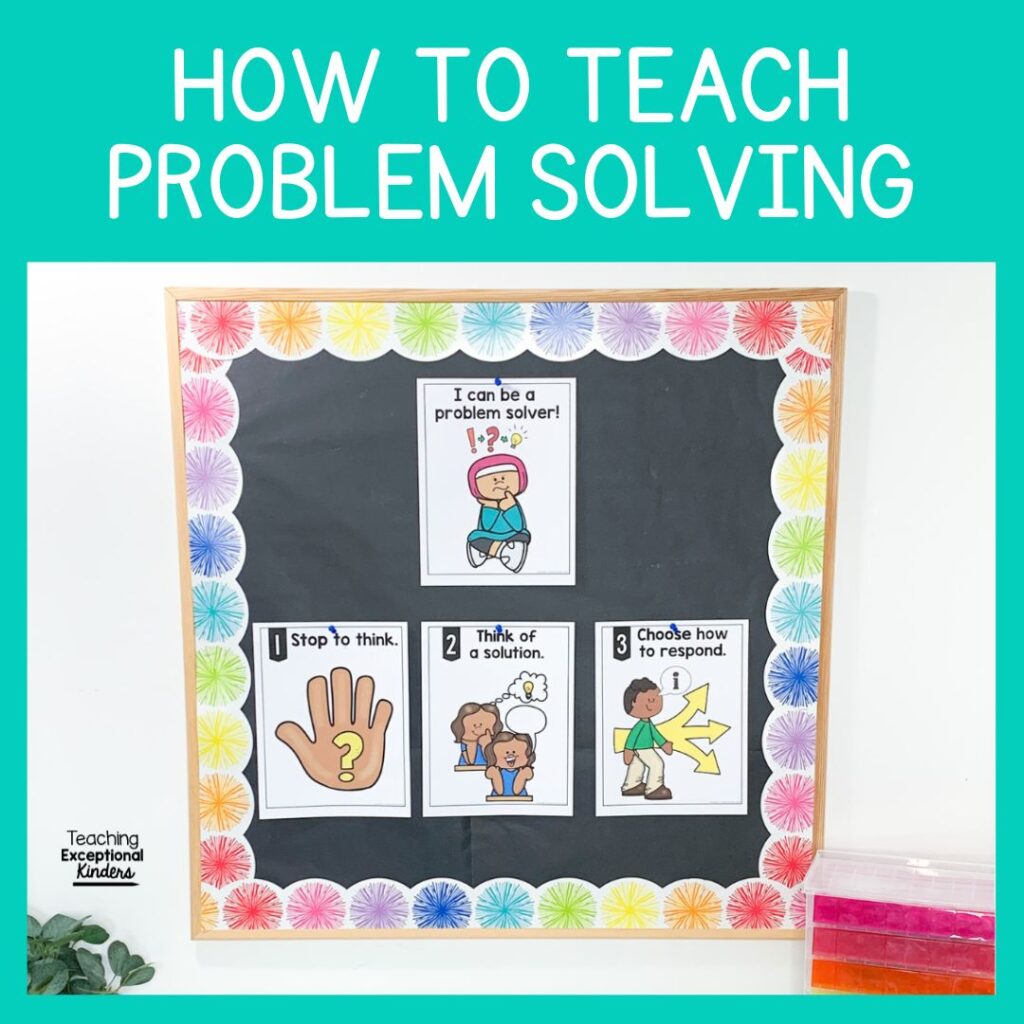
Tips for Teaching Problem Solving in Kindergarten
Learning how to problem solve is an advanced skill that people work on throughout their lives. We definitely shouldn't expect children to be perfect in this skill! However, your students can definitely start to understand that they can solve some of their small problems without adult intervention. Here are a few tips for how to teach problem solving in kindergarten.
1. Focus on Common Kindergarten Problems
When people think of solving problems in kindergarten, they often focus on conflict resolution between students. However, in kindergarten, there can be a wide range of challenges that students experience during the day. For young students, this often means turning to an adult for help.

Procedural – Kindergartners are very routine-oriented. When there is a small bump in the daily routines and procedures, the default is to ask the teacher what to do. These problems could include school supply issues or misplaced items.
Personal – Whether it’s untied shoes or complicated emotions, there are a variety of personal challenges that students experience throughout the school day. These could include personal injury, self-care challenges, and emotional regulation difficulties.
Interpersonal – Kindergarten can be a challenging time for students who are learning to interact with their peers! Students might experience problems related to turn-taking, making shared decisions, and working in groups. These are often the small problems that result in tattling.
2. Identify Your Preferred Solutions
Before teaching problem-solving skills to your students, take some time to identify the solutions that would be preferable in your classroom. For example, when a child finds a lost school supply on the ground, would you prefer that they try to find the correct location for it, put it in your classroom Lost and Found bucket, or set it on your desk?
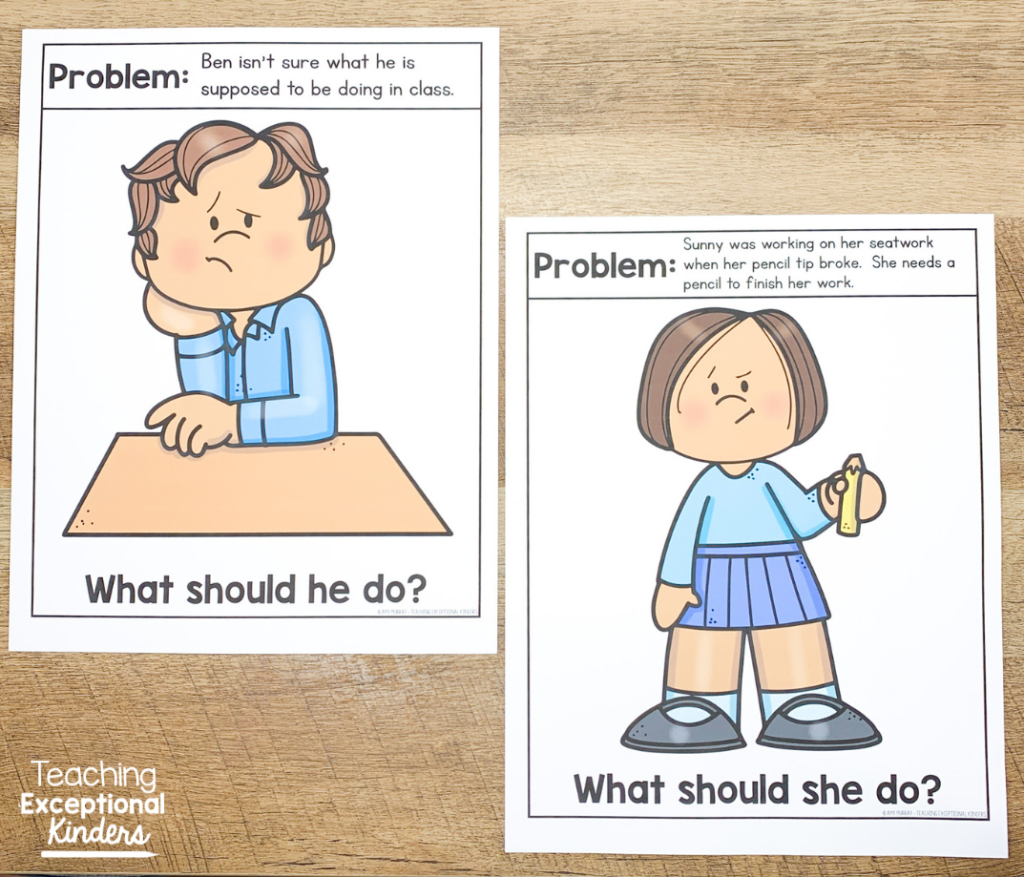
Since many of the challenges kindergartners experience can be procedural, it’s helpful to teach them appropriate solution options that fit within your classroom management system . For interpersonal problems, you might want to identify solutions that fit within your school’s conflict resolution procedures.
3. Teach the Steps of Problem Solving
Once you’ve identified the problems and solutions you’d like to discuss with your students, it’s time for the instruction! Teach your students the three easy steps of solving a problem:
First, they need to stop what they are doing. This helps them focus on the challenge they are facing.
Next, they need to think about the problem and possible solutions. Problems and solutions at school can often be different than those at home or other places.
Finally, they need to choose the best solution for their problem. They should consider how their solutions impact those around them.
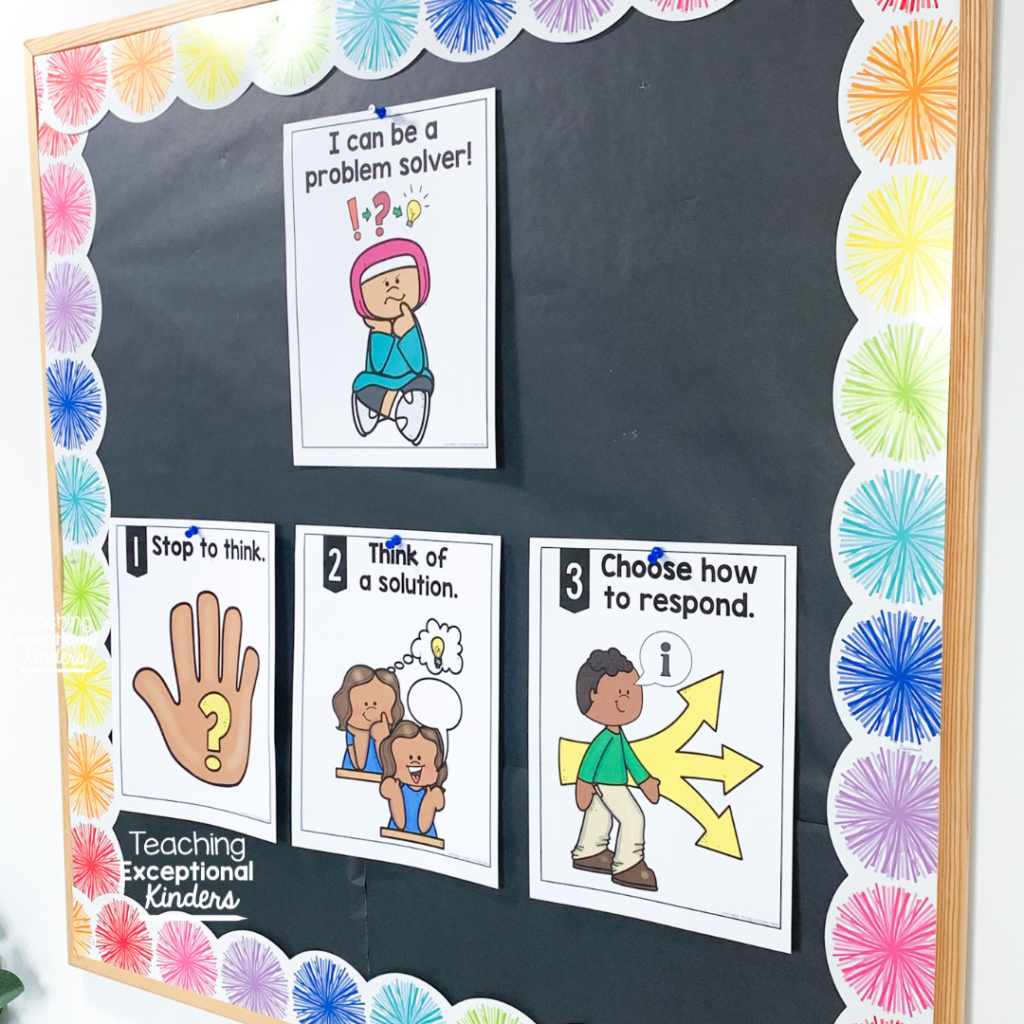
These simple steps are easy for students to remember so they are more likely to use them! It's a good idea to keep these reminders posted as visual support in the classroom so students can reference them throughout the school year.
4. Practice with Real-Life Scenarios
Now that you’ve introduced the steps to problem-solving, it’s time to practice using real-life examples and scenarios! Introduce a common problem that your students might experience in the classroom, on the playground, or even in the lunchroom. Discuss the problem so that all students can understand the challenge that needs to be addressed.
Once your students can identify the problem that needs to be solved, you can discuss possible solutions. It’s helpful for students to learn that there can be different ways to solve a problem. Sometimes students are hesitant to address challenges without adult intervention because they want to know what the “right” thing is to do.
Finally, it’s time for the students to choose the best solution. Students should think about how their solution will impact those around them and find the best option. You can discuss why this particular choice is the best option for the scenario.
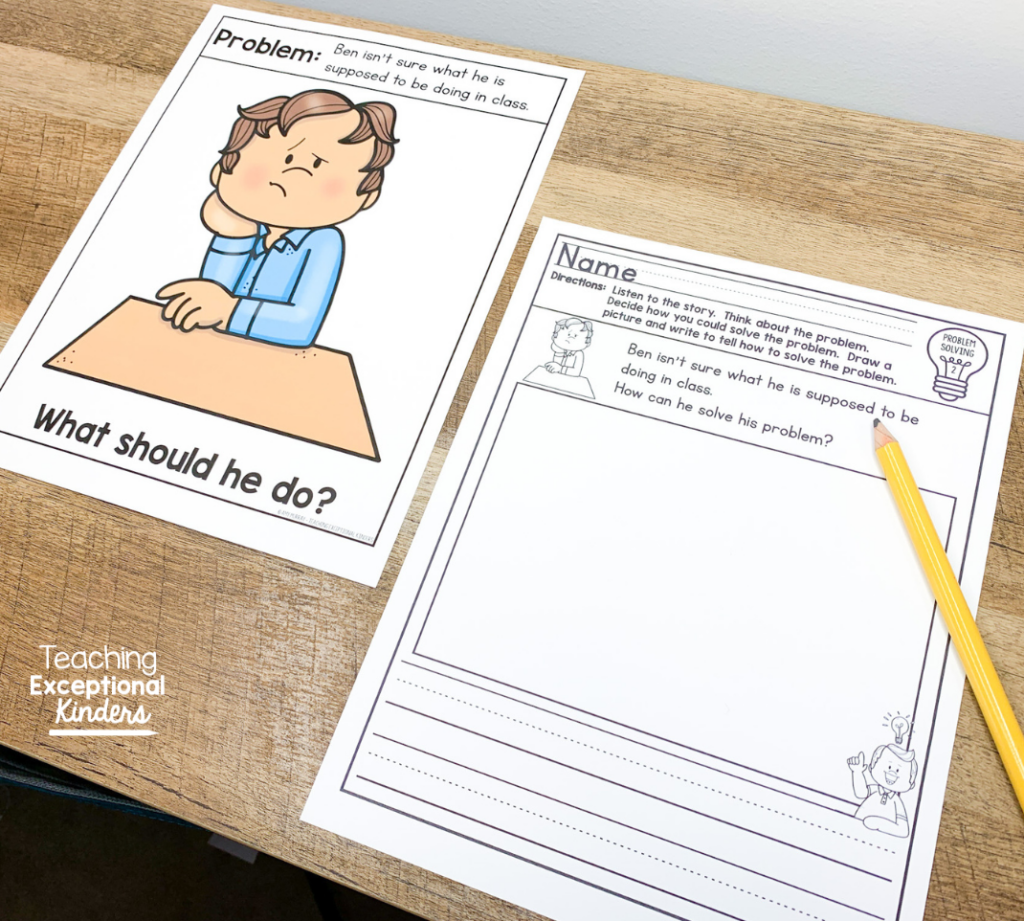
After discussing this real-life scenario together as a class, you can also encourage students to practice independently. Invite your students to complete an independent practice worksheet to show how they would solve the problem.
5. Repeat and Remind
It’s an ongoing process to teach students how to be more independent thinkers and problem solvers. This process of discussing real-life situations will be ongoing in your classroom. Take opportunities to repeat your instruction whenever you can!
Consider modeling for your students when there is a problem that you need to solve as a teacher. This helps them see that you go through the same three steps of problem solving! If a challenge arises that involves the whole class, you might also decide to discuss this together.
If you created an anchor chart during your class discussion of scenarios, you can keep those on display in your classroom. Problem solving posters can serve as a helpful reminder to your students when they find themselves in a challenging situation.
Problem Solving Printables for Kindergarten
Would you like to help your students become more independent in addressing their own challenges? I have created a resource to make it easy to teach problem solving in kindergarten.
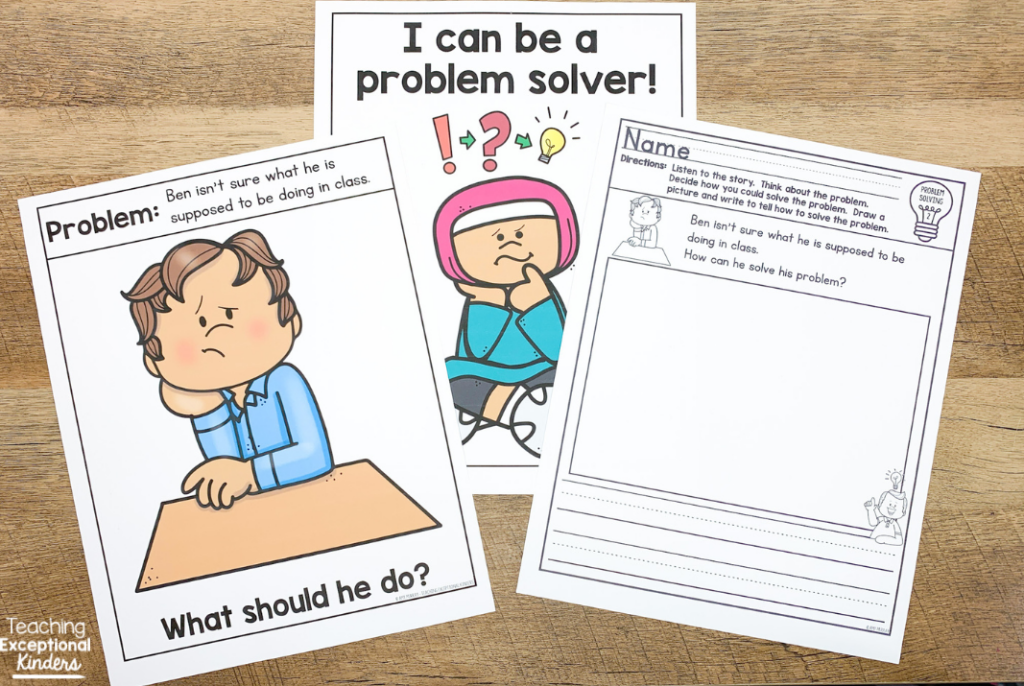
These posters and worksheets will help your students practice problem solving with engaging and relevant scenarios. Every classroom is different and each teacher sets specific classroom expectations. This resource is editable so that you can customize the problem solving scenarios to fit the needs of your classroom.
Would you like to take a closer look at everything included in this resource? You can find it in the Teaching Exceptional Kinders shop or on Teachers Pay Teachers .
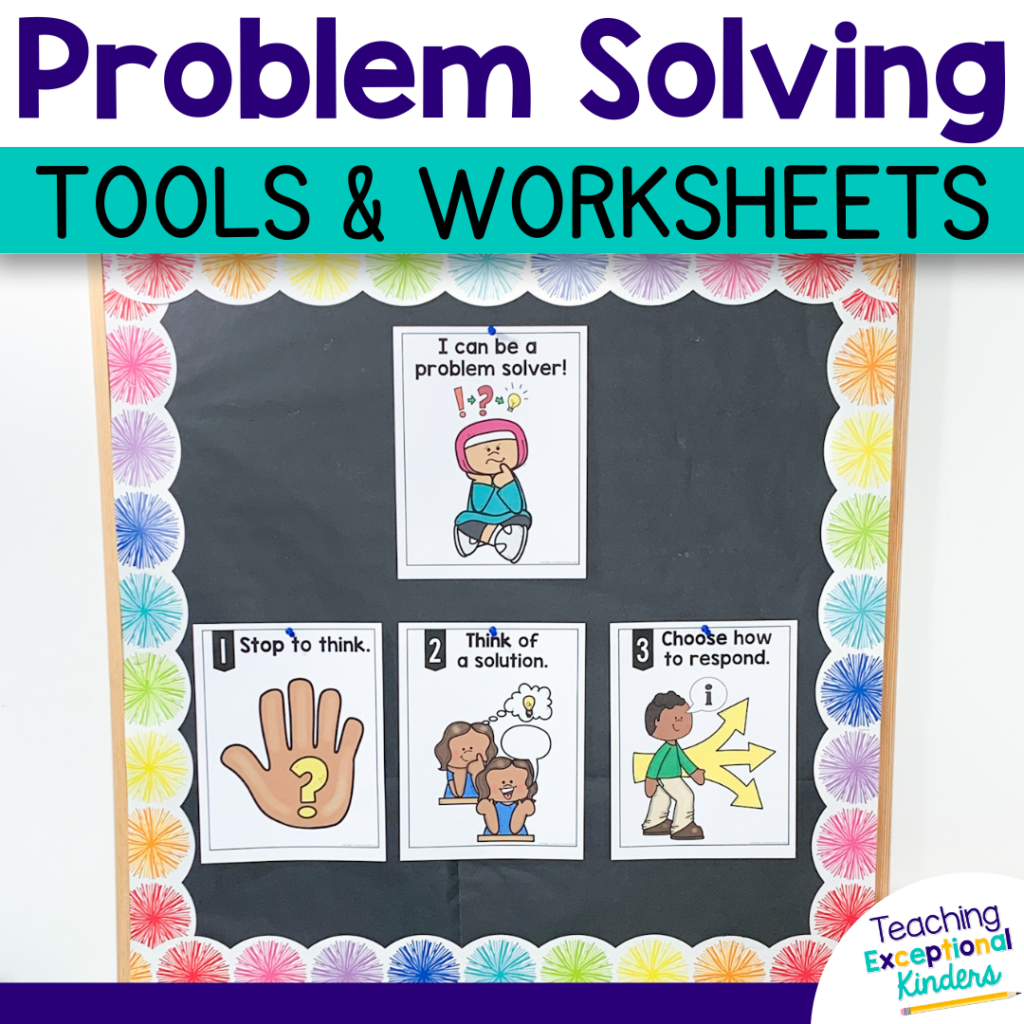
Save These Kindergarten Problem-Solving Ideas
Would you like to come back to this post later? Be sure to add this pin to your favorite teaching board on Pinterest. You’ll be able to quickly find these tips and resources whenever you need them!
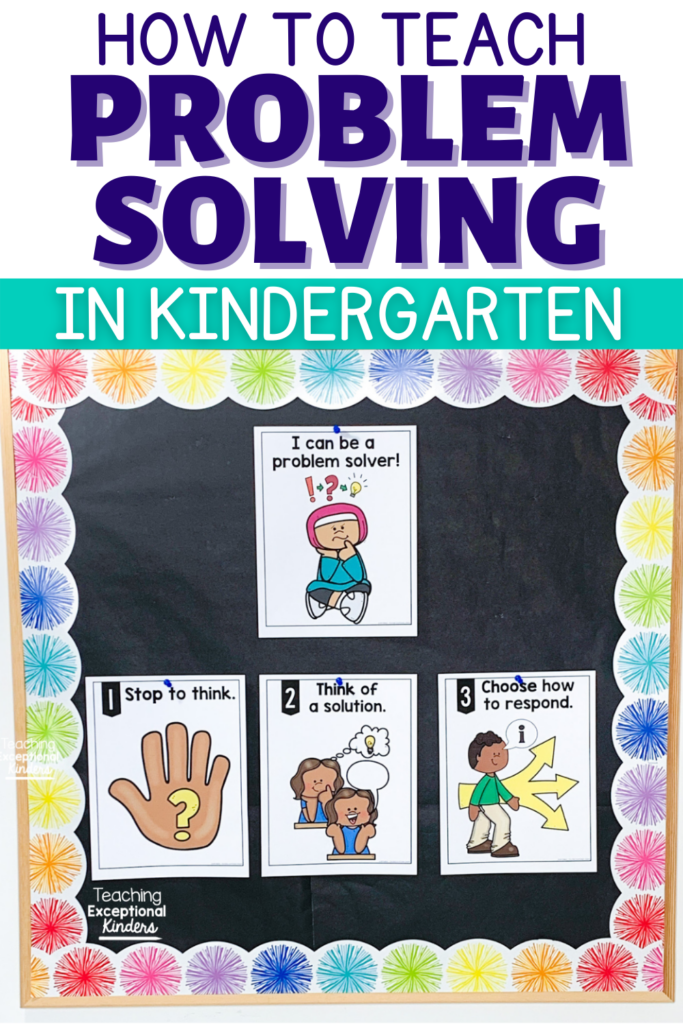
Leave a Reply Cancel reply
Your email address will not be published. Required fields are marked *
Save my name, email, and website in this browser for the next time I comment.
QUICK LINKS

Creative Kindergarten
Home » Teach Problem-Solving Skills With an Easy, No-Prep Activity
Teach Problem-Solving Skills With an Easy, No-Prep Activity

Explicitly teaching problem-solving skills to your students will have multiple benefits: easier classroom management , improved social-emotional learning, better self-regulation skills , and so much more. Finding the time and the resources to do it, though, can be tricky. My problem-solving task cards are here to help!
(I have used some affiliate links in this post)
Problem-Solving Task Cards
I wrote 32 prompts with common classroom scenarios. Everything from “A classmate took something out of my hand that I was using. What should I do?” to “I can’t get my jacket zipped up. What should I do?” These are common problems that come up in my classroom, and I know my students need help figuring out how to solve them.

Having task cards with the prompts written out ahead of time helps cut down on my planning time – I just need to pull the ring out, and I am ready to start my problem-solving lesson.
Problem-Solving Digital Slides
Don’t have the time to print them out? Go digital! Pull up the set of Google Slides with the prompts on them, and you can type the strategies that students come up with directly on the slides.
Problem-Solving Whole Group Instruction
I know that my students need to be explicitly taught the skills necessary to become problem solvers. Just like math and literacy skills , problem-solving is something that I want to model and teach my students.
I chose to use a puppet during these lessons (we have some similar to these ones ). I had my students pick a name for our puppet (Lily), and they would help her solve all her classroom problems. My students loved Lily! I often heard students ask each other throughout the day, “What would Lily do?” when they encountered a problem.

After reading a prompt, students would give ideas on how to solve the problem. I would take the time to model what that would look like in our classroom.
This is what it might look like when reading a problem-solving prompt:
Me: “I am not able to open my snack or lunch container. What should I do?” Student: “Get a teacher.” Me: “How can you get your teacher’s attention?” Student: “Raise your hand.” Me: “Once your teacher is there, what words will you use to ask for help?” Student: “I can’t open my container.” Me: “So, we can say something like, “Can you please help me open my container? Thank you!” Great idea! Is there another way we can solve this problem?”
After coming up with our solution, I might even have students act out the parts for their peers. This way, everyone clearly understands how they can be a problem-solver in each scenario.
Become a Problem-Solver
Grab the problem-solving task cards and slide deck so that you can start teaching your students how to become problem-solvers in the classroom!

Leave a Reply Cancel reply
This site uses Akismet to reduce spam. Learn how your comment data is processed .
Discover more from Creative Kindergarten
Subscribe now to keep reading and get access to the full archive.
Type your email…
Continue reading

71+ Free Social Problem-Solving Scenarios
Do you have kiddos who struggle with their social problem-solving skills? Teach your students the simple process of how to solve a problem along with having them review how well their solution worked or didn’t work.

Why Teach Problem Solving Skills?
Learning to problem solve is an essential skill that is used not only throughout childhood but also into adulthood. Social problem solving is the ability to change or adapt to undesirable situations that arise throughout our day.
On a daily basis, a child will encounter social problems that they will need to solve.
Anything from:
- arguing with another student
- to hurting a friend’s feelings
- to having a difficult conversation
- working with others
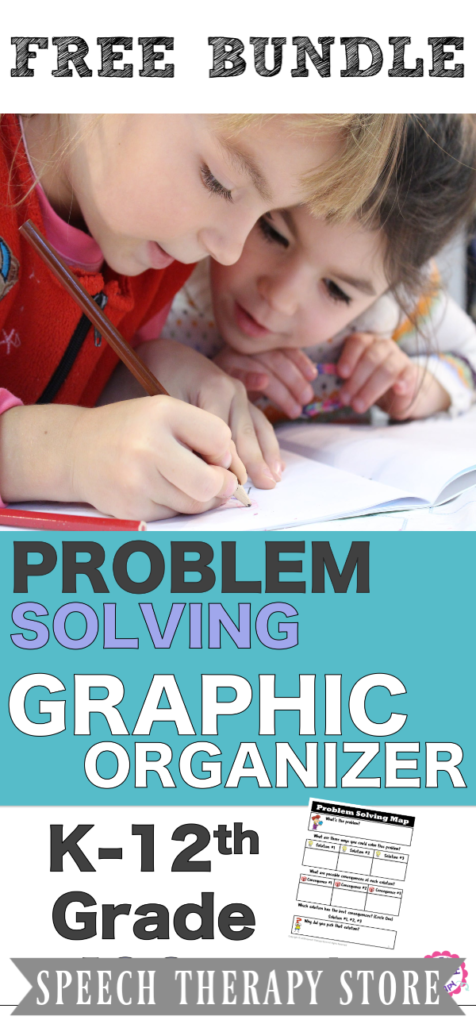
Start with Small Problems
Many of the “problems” children encounter are often small problems which the child may be over-reacting to, such as wanting a different coloring crayon or wanting to be first in line, however, these small problems are still very real to the child.
Practicing problem-solving with these small problems can be a great learning opportunity. Children can practice problem-solving with a small problem which can help them learn how to handle bigger problems in the future.
Problem Solving Importance
Social problem-solving skills are critical to a child’s social interactions, personal and professional relationships. A child’s ability to handle change, cope with stress, and handle challenges improves with a child’s ability to successfully solve social problems.
The ultimate goal is that the child will be able to solve social problems all on their own, but until they can independently solve a problem they will need to learn how to communicate and self-advocate to positively solve their problems.
Steps to Problem Solving
Children can be taught how to problem solve through a guided process of breaking down the problem and using simple steps to solve the problem.
Learning specific steps to problem-solving can allow children to remember how to solve a problem when they become overwhelmed or stressed.
Although learning to solve a problem independently can take some time and practice it is well worth the investment to have a child who can eventually solve most social situations in a positive manner on their own.
What we learnt about solving problems is don't freak out, if one thing doesn't work , try something else out. And work together as a team. #melthammathsweek #MELTHAMPUPILVOICE @problemsolveit pic.twitter.com/iVm1Im4Aue — yr6melthamce (@yr6melthamce) February 4, 2019
Problem Solving Form
Teach your students the 4 steps to becoming a social problem-solver.
- Identify the problem. For instance, start by having your student identify the social problem.
- Create three solutions. Also, have your student come up with three different solutions that they could use to solve the problem that they identified.
- Identify the consequences. Then, identify the consequence for each individual solution.
- Pick the best solution. Lastly, have your student identify which of their three solutions is the best choice Then have your student put into words why they think that solution is the best solution.

Problem Solving Review Form
After your students go through the social problem-solver have them use the social problem-solving review form.
- What happened. For instance, after your student tried their solution have them explain what happened next.
- Review the results. Also, have your student identify whether or not their solution got them the results they wanted.
- Use this solution again. Furthermore, have your student identify whether or not they would use this solution again in the future to solve the same or similar problem.
- What would you do differently? Finally, have your student explain what they would do differently if they didn’t get the results they wanted or if they wouldn’t use that solution again in the future.

71+ Social Problem Scenarios + 6 Blank Scenarios
Use the 71 social problem-solving scenarios to have your students get great experience practicing how to solve a social problem.
Also, included are 6 blank scenarios. Then laminate them so you can use them over and over again. Therefore, create social problems that the student experiences and needs help solving.

Wordless Video teaching Problem Solving
Watch this super cute wordless animation with your students and have them discuss the problem they see and how to best solve the problem.
Use this as a fun practice example to get your students started towards learning how to problem-solve.
Demonstrate Through Modeling
Model and discuss empathy.
First and foremost, children need to understand how another person might be feeling in a given situation in order to become a good social problem solver. The student needs to learn how to “stand in someone else’s shoes” for a little bit.
One way you can work on this skill is during the reading time you can focus on how a particular character in the story might be feeling.
Ask questions, such as:
- “How do they feel right now?”
- “How would you feel in that same situation?”
- “Why do you think they feel that way?”
Model Problem-Solving Skills as the Teacher
When you are faced with a problem you can solve the problem by thinking aloud for the students to hear how you solve a problem.
You can state the problem, then come up with possible solutions, then identify the possible consequences to each solution, then pick and explain why a solution is the best option.
For example, you could say, “I was hoping to take the class outside for a stress walk around the track before the reading test, but the problem is that it is raining outside. I could still take you outside, but then you will get wet, or we could walk the halls, but then we’d have to be really quiet because there are other classes learning, or we could just skip the walk and take the reading test, but then you might not do as well on the test. I think based on all of those solutions the best solution will be to walk the hallway, but you guys will have to promise to be quiet so that we don’t disrupt other classes.
Modeling the problem-solving process can be very helpful for the students to watch, observe, and later implement themselves.
Teach Communication
Have students communicate how they are feeling.
Teaching your students to share their emotions in a respectful way can improve their ability to problem-solve.
Have students use an “I” sentence frame, such as, “I feel _____ (insert feeling word) when _____ (identify what made you feel that way).”
For example, “I felt sad when Jackson broke my favorite pencil” or “I was mad when I wasn’t picked to be first in line.”
This way students can communicate how they are feeling using honest and open communication. Teaching students to appropriately communicate their emotions can help solve some social problems from the beginning.
Encourage Independency
Encourage your student to problem solve.
If your student is struggling to problem solve independently encourage them to do so using open-ended questions.
- “How could you fix this problem?”
- “What would be a fair solution?”
- “What would happen if you used that solution?”
Let the Student try to Problem Solve Independently
Give your students the space to try and solve their own problems using the guided strategies. Try not to come running to their rescue for every little problem.
Some problems are small and a great opportunity for the student to learn and practice. If an adult does all of the problem solving for a student then what are they really learning?
Give your students the time and space they need to practice solving small problems on their own. Of course, if it is a bigger or more serious problem then have an adult help guide the problem-solving process.
Tell an Adult
Remind your students that there are still some problems that are too big for them to solve on their own and that it is okay to get help from an adult to solve big problems.
For example, if the student doesn’t feel safe, someone is being hurt physically or emotionally, or if they tried to solve a problem independently but it didn’t work and they need help. Let them know that it’s okay to tell an adult.
Teach How to Disagree and How to Make Up
Discuss how to disagree respectfully.
Remind your student that they won’t always agree with their teacher, friends, classmate, or parents and that’s okay. Even the people we like might have different opinions, interests, and likes than we do.
However, even if we disagree with someone we should still treat them with respect. Treating someone with respect means to not call them names, ignore them, yell or hit them. It means that you do try to create solutions that both parties can agree with and to apologize when we hurt others’ feelings.
Role-Play How to Make Up
Practice in everyday life how to make up after a social problem .
Students are really having to stretch their brains today. It's @NSPCC #NumberDay and @problemsolveit are challenging Y9 and 10 to solve the escape room boxes. It's not as easy as it looks! The promise of a few sweet treats for the winners seems to be helping though! pic.twitter.com/AxRRJnJIv2 — CongletonHS (@CongletonHS) February 2, 2018
Be sure to get your free social problem solver today below! I hope you and your students love this freebie.
Have your students use task card scenarios to help them identify how they and others might feel in different social scenarios. Be sure to discuss the problem, identify possible solutions, identify the consequences of those possible solutions, and then based on those consequences pick the best solution.
Make social problem-solving a game by telling the students that they are social detectives and that it is their job to use what they know about social rules to help them identify the possible and best solutions.
Start practicing today with 71+ free social problem social task cards! Do your students need more practice?
Be sure to check out my other freebie for 31 wordless animated videos to teach problem-solving and so much more.
Make Problem Solving Easier with this Freebie!
Download yours today to get started.
Get More Problem Solving Time Saving Materials
Next, be sure to check out the following time-saving materials to continue to teach your students how to solve their social problems in addition to this freebie.
Weekly Social Pragmatics Homework

- Weekly problem-solving. Send home a weekly homework page that includes a problem-solving scenario plus an idiom and a conversational practice scenario.

Restorative Justice Problem Solving Flip Book

- Restorative justice graphic visual. Use this graphic visual to help your student restore a social relationship after a social problem.

Self-Advocating Role-Play Scenarios

- Self-advocating in high school. Teach your high schoolers the process to self-advocate for what they need.

5th-12th Grade Life Skills Problem Solving

- Life skills problem-solving. In addition, this life skills differentiated bundle includes a problem-solving lesson plan.

I recommend you read Problem Solving Wheel: Help Kids Solve Their Own Problems , 61+ Free Fillable SLP Planner Pages 2020-2021 , 430+ Free Multisyllabic Words List Activity Bundle , or 432+ Free IEP Goal Bank to Save You Time posts because they include freebies as well and who doesn’t want more freebies!
Got questions? Leave a comment. Let’s chat!
Monday 30th of January 2023
Hello! I have entered my name and email twice (yesterday & today) to receive to 71+ Free Social Problem-Solving Senarios, but I have not received anything yet. Not even an email back to mine in order to subcribe. Thanks for your help! Tracy
Melissa Berg
Tuesday 31st of January 2023
Hi Tracy, Thanks so much for reaching out! Sorry about that. We went ahead and sent you an email with the PDF attached. Wishing you all my best, Melissa
Problem Solving Skills
Tuesday 30th of August 2022
I truly love your site. Excellent colors, theme and writing. Thanks for sharing.
Laura Ricca
Monday 11th of April 2022
Tuesday 12th of April 2022
Hi Laura, I'm glad you found this resource helpful. Melissa
Modified Mental Health and Suicide Prevention - Speech Therapy Store
Monday 11th of May 2020
[…] 71+ FREE SOCIAL PROBLEM-SOLVING SCENARIOS […]
Problem Solving Wheel: Help Kids Solve Their Own Problems - Speech Therapy Store
Monday 4th of May 2020
[…] 71+ Free Social Problem Solving Task Cards Scenarios […]
Atlas Mission
Navigate to...
10 kindergarten problem solving skills for your little champ.

Want to Improve Your Child's Problem Solving Skills?
Enroll your child for the Atlas Mission – the ultimate learning companion for kids.
One fine day, I was making my 5 year old memorize his dad’s number – you know, just in case of an emergency! After spending roughly half an hour on the exercise, I decided to test what his little mind had grasped.
“Ok honey, if mommy suddenly falls sick and can’t get out of bed, what are you going to do?”
He didn’t even bat an eyelid before replying, “I’ll eat all the choco-chip cookies I can find in the kitchen.”
To his credit, he did come up with a creative answer to the question… just that it wasn’t exactly the kind of problem solving skill I was hoping for him to acquire!
Trying to bury this particular episode in some remote corner of my brain, I once again bravely attempted to improve my creative child’s problem solving skills – this time around, with desired results (thankfully!).
So here are the 10 kindergarten problem solving skills for kids that helped my little one get smarter while keeping him thoroughly entertained too, an impressive feat to achieve!
1. Puzzle Time
My kindergartener loves to click pictures on my phone, so if anyone happens to open my gallery, they’d know how much I adore my pet dog and my son’s Mickey Mouse pyjamas and his storybooks and the ceiling of my room and of course, the darned choco-chip cookies!
Anyway, if your little one is a budding photographer too, just get a few of his works printed, paste the pictures on a cardboard and cut them carefully to form puzzles for him to solve.
2. What’s in the Bag
This activity is all about letting your child explore the sense of touch. Collect a few different-shaped and sized objects like ball, plush toy, book, comb, keys, crayon, spoon etc. and put them all in a bag.
Now let your child touch each object one-by-one and identify what it is. Once she identifies all objects correctly, you can increase the level of difficulty by opting for objects that are slightly similar like different plush animals (same size) or cars of different models.
Mazes are an engaging activity that kids love. Problem-solving with mazes requires your child to concentrate in a fun way and they help hone her motor skills too.
You can find a number of free printable mazes on the Internet according to your child’s age. Alternatively, you can create them at home too.
Pro Tip: Help Your Child Become Better at Problem Solving
Enroll your child for the Atlas Mission and let your child play with this award-winning educational program. Your child will become better at problem solving without even realizing it!
4. Duplicate my Structure
I am sure your kindergartener must be having truckloads of building blocks of every shape and size. Every kindergartener does.
Now it is time for you to get creative and build a model out of those blocks. Remember to spare enough blocks for your child to duplicate the model. Set a time limit for her to finish the task.
Start by building easy models and then move on to difficult ones.
5. Shape Sudoku
Sudoku is an interesting Japanese puzzle where the player is required to fill empty places in a grid with numbers, making sure no number is repeated in a row or column.
Shape Sudoku replaces numbers with shapes, to make it more fun for kindergarteners, and is a great way to improve your little one’s problem solving skills. You can give him a 4*4 grid for starters and then gradually raise the level of difficulty.
There are scores of simple, printable shape Sudoku puzzles available on the Internet, so just print a few and treat yourself to a relaxing evening while your little monster gets busy wracking his tiny brain.
6. Treasure Hunt
This is an activity my kid absolutely loves, though I believe that’s because he gets his favorite snack in the end! I just tape little notes in different corners of his room, each note giving a clue on where to find the next one, and the last one leading him to his snack.
Not only did treasure hunt help hone my child’s problem solving skills, it also made him learn how to read words like cupboard, flower pot, laptop, pen holder, school bag etc. Good job, mommy (patting my back)!
7. My Name in the Square
Now that’s a game most of us played when we were kindergarteners. I remember I did and was quite good at it too (so that kind of explains why I’m such a problem-solving genius. At least, that’s what my husband believes, bless him!).
So to play this game, make rows of dots, you can start with six dots in six rows. Now take turns with your child drawing one line to connect two dots, either horizontally or vertically. One who completes a box writes their name in it and takes another turn. The one with more names in the boxes wins.
Pro Tip: If you don’t want a wailing child at the end of the evening, let him win a few games too. I know it is hard, but give it a try!
8. Trial and Error Learning
Whenever we buy a new gadget, we usually spend a good deal of time trying to figure out how it works, don’t we? Since I am more technologically challenged than I would care to admit, I sometimes end up spending days understanding the nitty-gritties of my new gadgets.
Now this is exactly what you need to do with your kiddo too. When you’re giving him a new toy/game, don’t tell him right away how it works. Let him struggle a bit and discover things through ‘trial and error’.
As a parent, I know you’ll feel the urge to step in and make things simpler for your munchkin. But I assure you, his joy of solving a new puzzle all by himself, or of figuring out how the controls of his latest car work will be unmatched.
9. ‘What will you do?’ Game
All the above mentioned problem solving skills require your little one to use her brain creatively, which is great, but what about the problems your child might encounter while interacting socially?
This activity involves giving your child a particular situation, framing a set of ‘What will you do?’ questions and then giving her four alternatives for each.
For example: If you fall down in class and your friend starts laughing, what will you do?
- Get up like nothing happened and go back to your seat.
- Ask her to stop as there’s nothing funny about it.
- Start crying.
- Stop talking to her for a while.
To make this activity more interesting and fun, you can draw the four alternatives on a piece of paper and then ask your child to color the one she’d choose. Since I suck at drawing, I got the pictures printed instead.
10. Put my Lid Back
Take a few empty bottles and jars of varying sizes and unscrew their caps/lids. Now ask your child genius to put the correct lid on each one. Again you can use a stopwatch to check how much time he takes to finish the task.
So these 10 kindergarten problem solving skills for kids are sure to give an edge to your little one’s already impressive personality and ensure he keeps himself busy doing something productive too, for a change! And yes, you can thank me later!
Facebook Pinterest Google+
Related Articles
5 Awesome Kindergarten Problem Solving Games your Child Will Love
The 8 Best Problem Solving Strategies for the Preschool Mind
8 Problem Solving Games to Play With Your Preschooler
More Preschool and Kindergarten Problem Solving Articles...
Popular Articles
10 Sneaky Ways to Trick Your Kids into Learning Math
First Steps Towards Coding for Preschoolers: Understanding Instructions
5 Ways to Kill Your Child’s Creativity
10 Ways to Supercharge Your Child’s Science Skills

About the Author
Pooja Jain creates educational content for the Atlas Mission . She is a mother of two sweethearts, a travel enthusiast and a self-proclaimed singer. On days she’s not busy running after her little humans, you can find her reading fiction while downing copious amounts of coffee.

Liked this article? Don’t miss our next one.
Our blog publishes free tips for busy parents like you to help you improve your child’s Reading, Math, Science and 21st century skills.
Follow us and get weekly updates containing some of our most exclusive content.

- ELEMENTARY TEACHING , SOCIAL EMOTIONAL LEARNING IN THE CLASSROOM
SEL Problem Solving: How to Teach Students to be Problem Solvers in 2024
If you are an elementary teacher looking to learn how to help your students solve problems independently, then you found the right place! Problem solving skills prepare kids to face dilemmas and obstacles with confidence. Students who have problem solving skills are more independent than students who do not. In this post, we’ll go into detail about what problem solving skills are and why they are important. In addition, we’ll share tips and ideas for how to teach problem solving skills in an elementary classroom setting. Read all about helping students solve problems in and out of the classroom below!
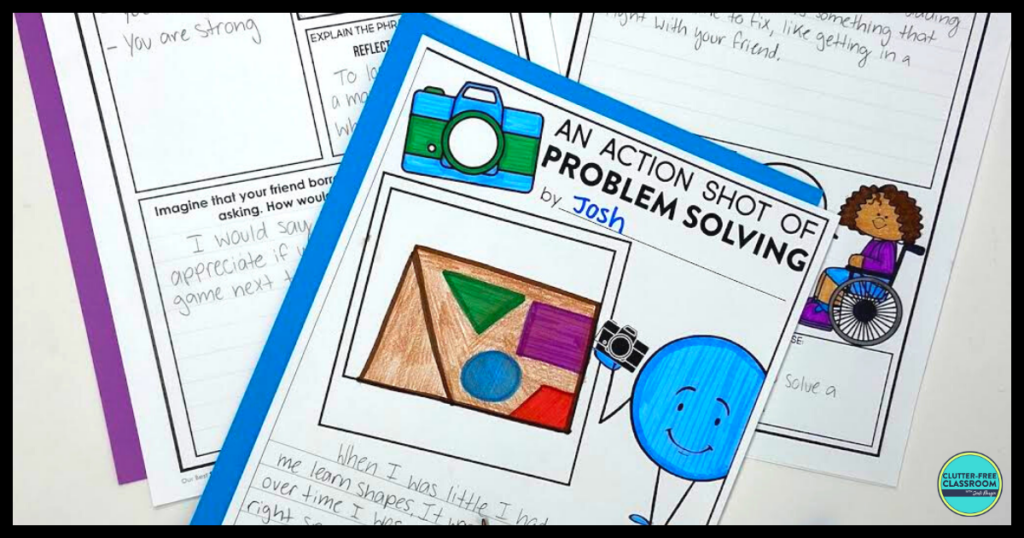
What Does Solving Problems Mean?
Solving problems means brainstorming solutions to the problem after identifying and analyzing the problem and why it occurred. It is important to brainstorm different solutions by looking at all angles of the problem and creating a list of possible solutions. Then you can pick the solution that fits the best.
Why is it Important for Kids to Solve Problems?
It is important for kids to solve problems by brainstorming different solutions so that they can pick the best solution. This teaches them that there can be many different solutions to a problem and they vary in effectiveness. Teaching kids to solve problems helps them be independent in making choices.
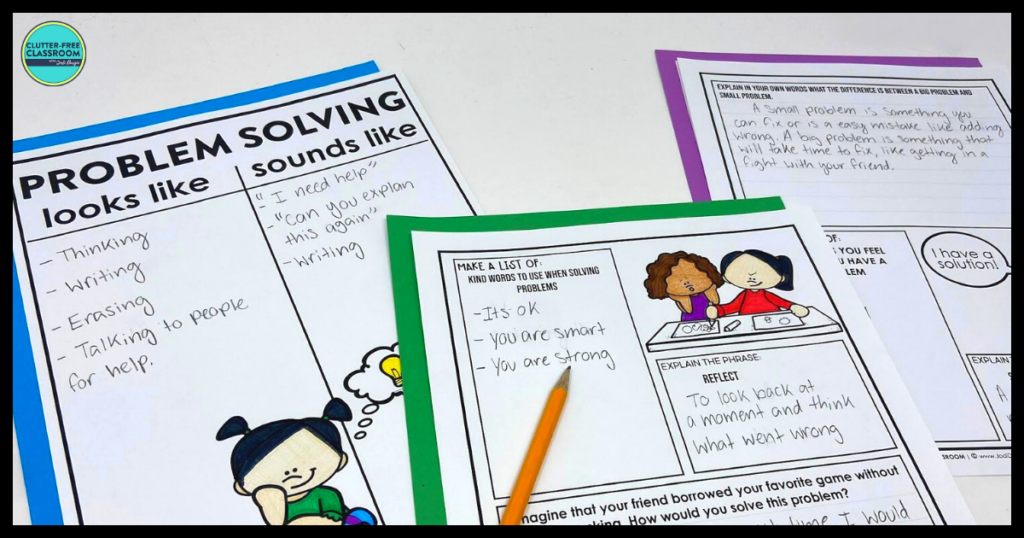
How Do I Know If I Need to Teach Problem Solving in My Classroom?
The students in your 1st, 2nd, 3rd, 4th or 5th grade classroom would benefit from problem solving lessons and activities if any of these statements are true:
- Student confidence is lacking.
- Students are getting into conflicts with each other.
- They come to you to solve problems they could have solved on their own.
- Students are becoming easily frustrated.
- Recess is a hard time for your class.

5 Reasons To Promote Problem Solving In Your Elementary Classroom
Below are 5 reasons to promote problem solving in your elementary classroom.
1. Problem solving builds confidence
Students’ confidence will grow as they learn problem solving skills because they will believe in their own abilities to solve problems. The more experience they have using their problem solving skills, the more confident they will become. Instead of going to others to solve problems for them, they will look inside themselves at their own abilities.
2. Problem solving creates stronger friendships
Students who can problem solve create stronger friendships because they won’t let arguments or running into issues stop them from being friends with a person. Instead they work with their friend to get through their problem together and get through the bump in the road, instead of giving up on the friendship.
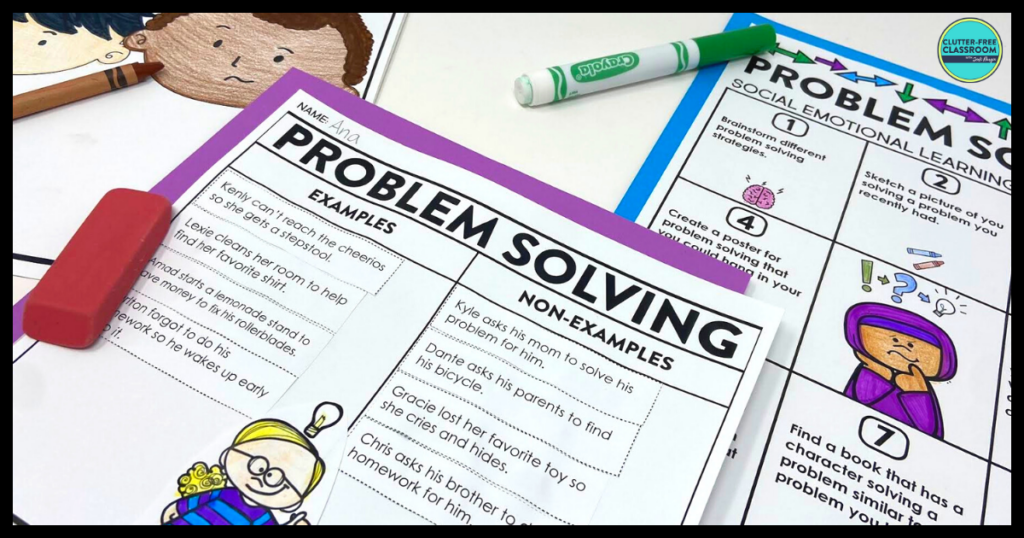
3. Problem solving skills increase emotional intelligence
Having emotional intelligence is incredibly helpful when solving problems. As students learn problem solving skills, they will use emotional intelligence to think about the feelings of others involved in the conflict. They will also think about how the problem is affecting others.
4. Problem solving skills create more independent kids
Students who can problem solve become more independent than kids who cannot because they will try to solve their problems first instead of going to an adult. They won’t look at adults as being the only people who can solve their problems. They will be equipped with the skill set to tackle the problems they are experiencing by themselves or with peers. However, it is important to make the distinction with kids between problems they can solve on their own and problems they need an adult for.
5. Teaching problem solving skills causes students to be more reflective
Reflecting is part of the problem solving process. Students need to reflect on the problem and what caused it when deciding how to solve the problem. Once students choose the best solution to their problem, they need to reflect on whether or not the solution was effective.
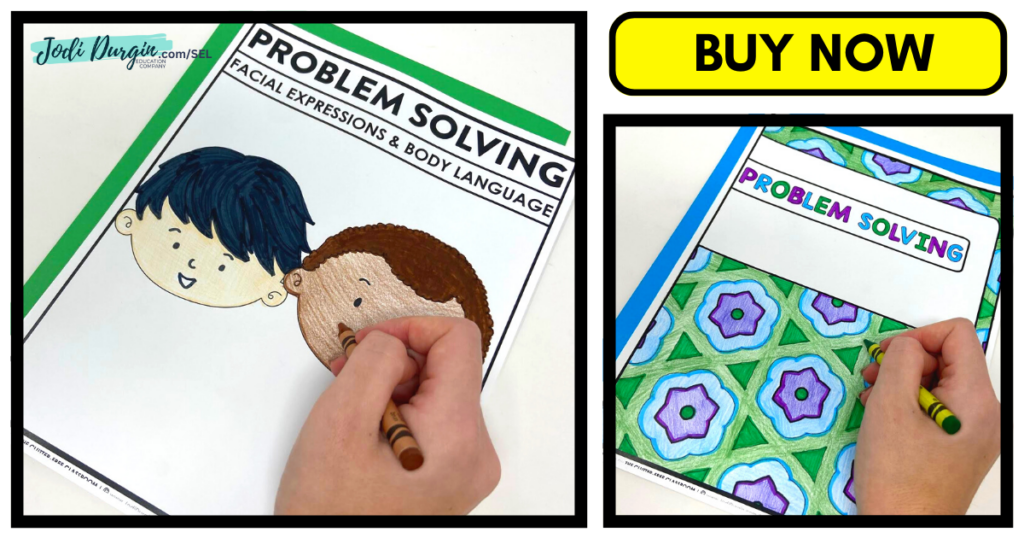
5 Tips and Ideas for Teaching Problem Solving Skills
Below are tips and ideas for teaching problem solving.
1. Read Aloud Picture Books about Problem Solving Skills
Picture books are a great way to introduce and teach an SEL topic. It gets students thinking about the topic and activating their background knowledge. Check out this list of picture books for teaching problem solving skills !
2. Watch Videos about Problem Solving Skills
There are tons of free online videos out there that promote social emotional learning. It’s a fun and engaging way to teach SEL skills that your students will enjoy. Check out these videos for teaching problem solving skills !
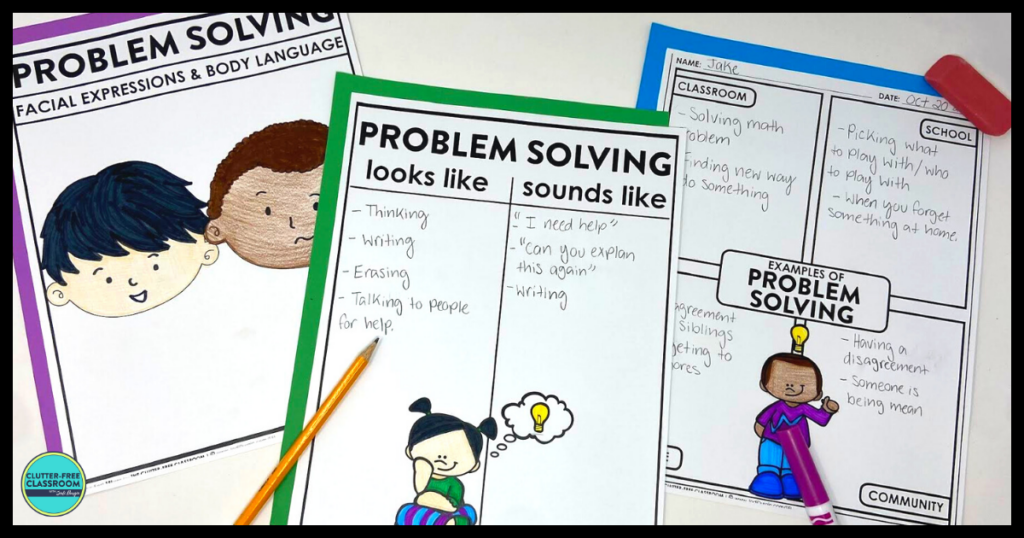
3. Explicitly Teach Vocabulary Related to Problem Solving Skills
Vocabulary words can help students develop understanding of problem solving and create connections through related words. Our problem solving SEL unit includes ten vocabulary cards with words related to the SEL topic. It is important for students to be able to see, hear, and use relevant vocabulary while learning. One idea for how to use them is to create an SEL word wall as students learn the words.
4. Provide Practice Opportunities
When learning any skill, students need time to practice. Social emotional learning skills are no different! Our problem solving SEL unit includes scenario cards, discussion cards, choice boards, games, and much more. These provide students with opportunities to practice the skills independently, with partners or small groups, or as a whole class.
5. Integrate Other Content Areas
Integrating other content areas with this topic is a great way to approach this SEL topic. Our problem solving SEL unit includes reading, writing, and art activities.
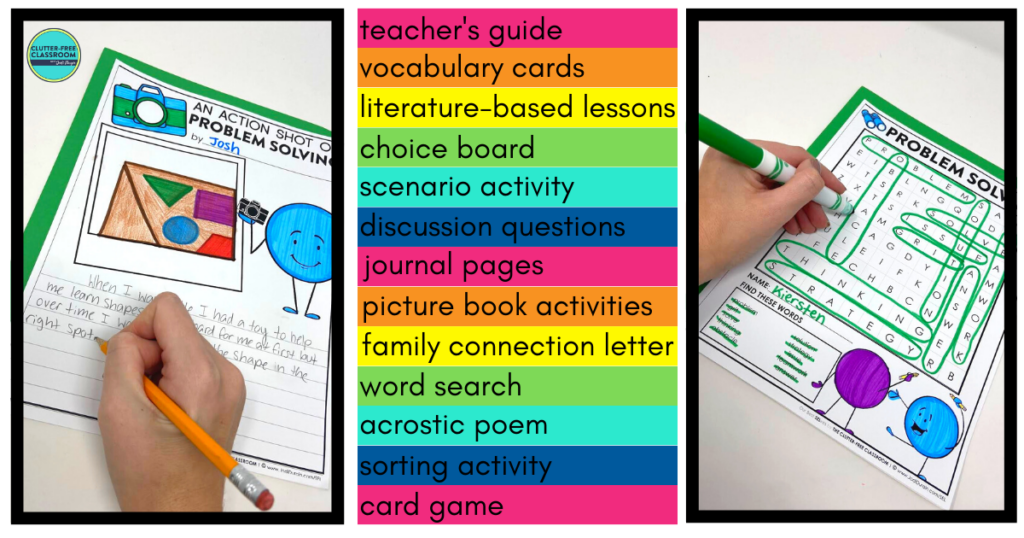
Skills Related to Problem Solving
Problem-solving, in the context of social emotional learning (SEL) or character education, refers to the process of identifying, analyzing, and resolving challenges or obstacles in a thoughtful and effective manner. While “problem-solving” is the commonly used term, there are other words and phrases that can convey a similar meaning. These alternative words highlight different aspects of finding solutions, critical thinking, and decision-making. Here are some other words used in the context of problem-solving:
- Troubleshooting: Identifying and resolving problems or difficulties by analyzing their root causes.
- Critical thinking: Applying logical and analytical reasoning to evaluate and solve problems.
- Decision-making: Considering options and making choices to address and solve problems effectively.
- Analytical problem-solving: Using data, evidence, and systematic thinking to address challenges and find solutions.
- Creative problem-solving: Generating innovative ideas and approaches to overcome obstacles and find solutions.
- Resourcefulness: Finding effective solutions using available resources and thinking outside the box.
- Solution-oriented: Focusing on identifying and implementing solutions rather than dwelling on problems.
- Adaptability: Adjusting strategies and approaches to fit changing circumstances and overcome challenges.
- Strategic thinking: Planning and organizing actions to achieve desired outcomes and resolve problems.
- Systems thinking: Considering the interconnectedness and relationships between different elements when solving problems.
These terms encompass the concept of problem-solving and reflect the qualities of critical thinking, decision-making, and finding effective solutions within the context of social emotional learning (SEL) or character education.
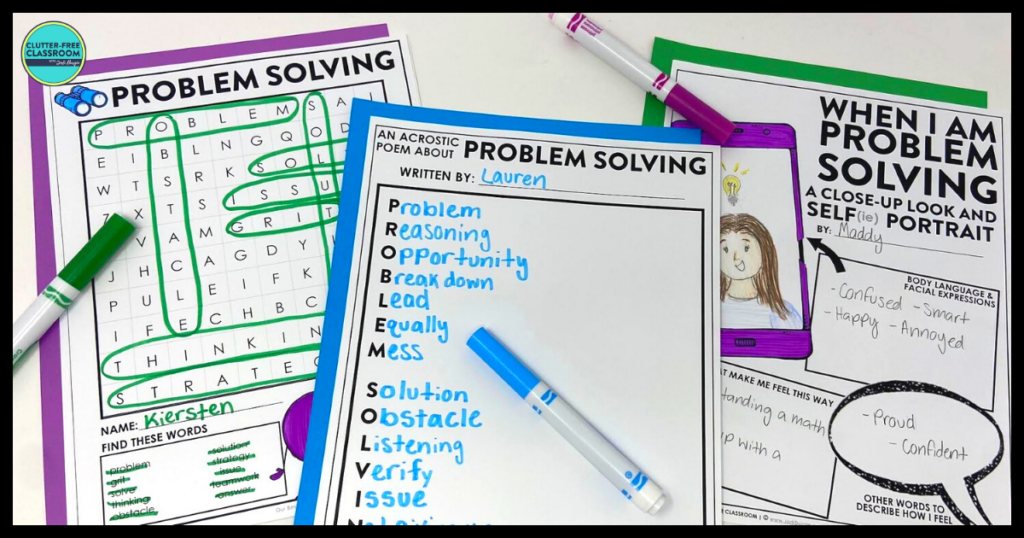
Download the SEL Activities
Click an image below to either get this individual problem solving unit or get ALL 30 SEL units
In closing, we hope you found this information about teaching problem solving skills helpful! If you did, then you may also be interested in these posts.
- SEL Best Practices for Elementary Teachers
- Social Emotional Learning Activities
- 75+ SEL Videos for Elementary Teachers
- Teaching SEL Skills with Picture Books
- How to Create a Social Emotional Learning Environment
You might also like...
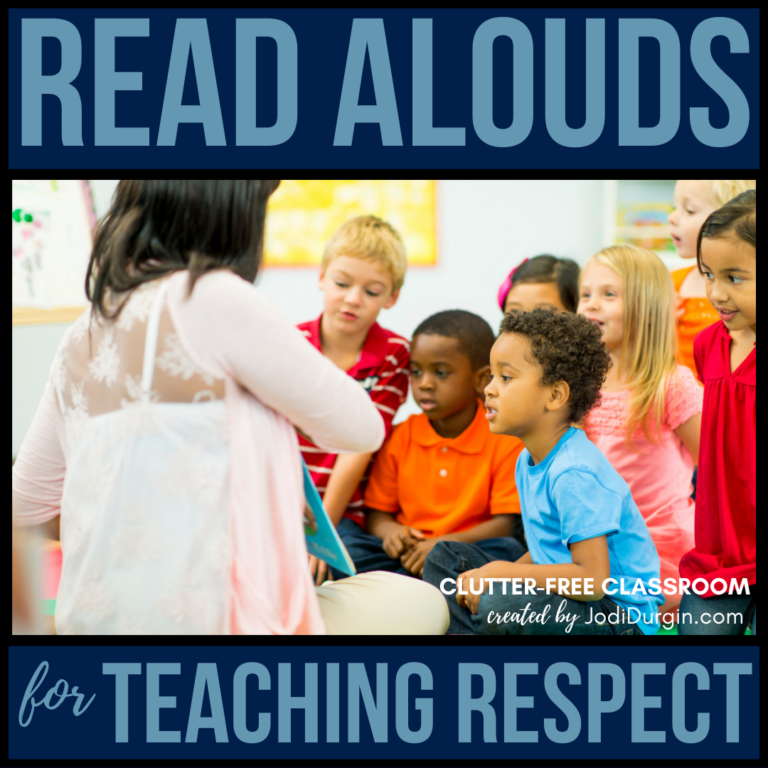
5 Read Alouds about Respect for Elementary Teachers in 2024
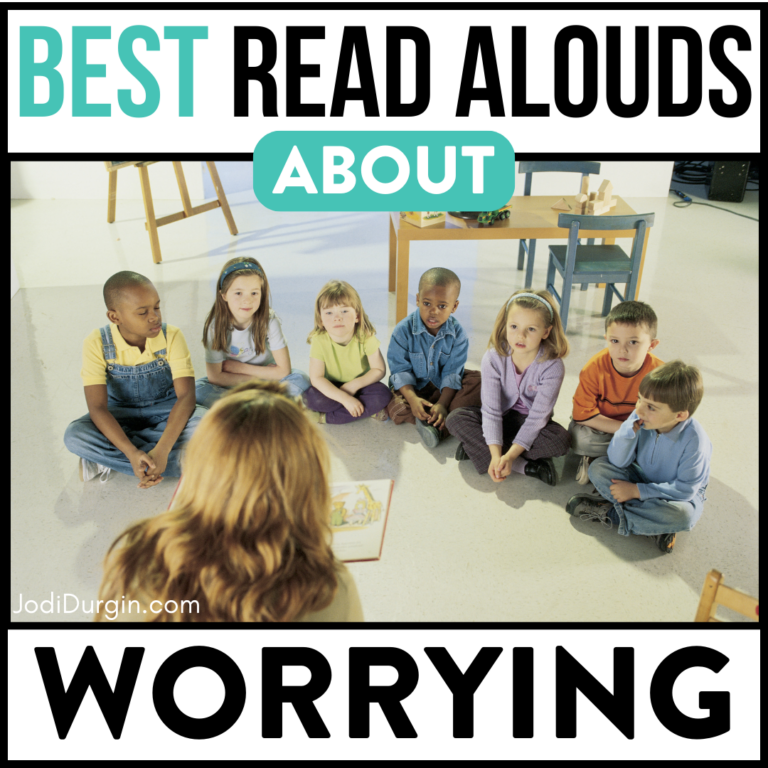
8 Children’s Books about Worrying for Elementary Teachers in 2024

8 Self Regulation Books for Elementary Teachers – 2024
Join the newsletter.

- CLUTTER-FREE TEACHER CLUB
- FACEBOOK GROUPS
- EMAIL COMMUNITY
- OUR TEACHER STORE
- ALL-ACCESS MEMBERSHIPS
- OUR TPT SHOP
- JODI & COMPANY
- TERMS OF USE
- Privacy Policy

10 Simple Activities to Teach Your Preschooler Problem Solving
By: Author Tanja McIlroy
Posted on Last updated: 7 April 2024
Categories Activities for Preschoolers & Kindergarteners
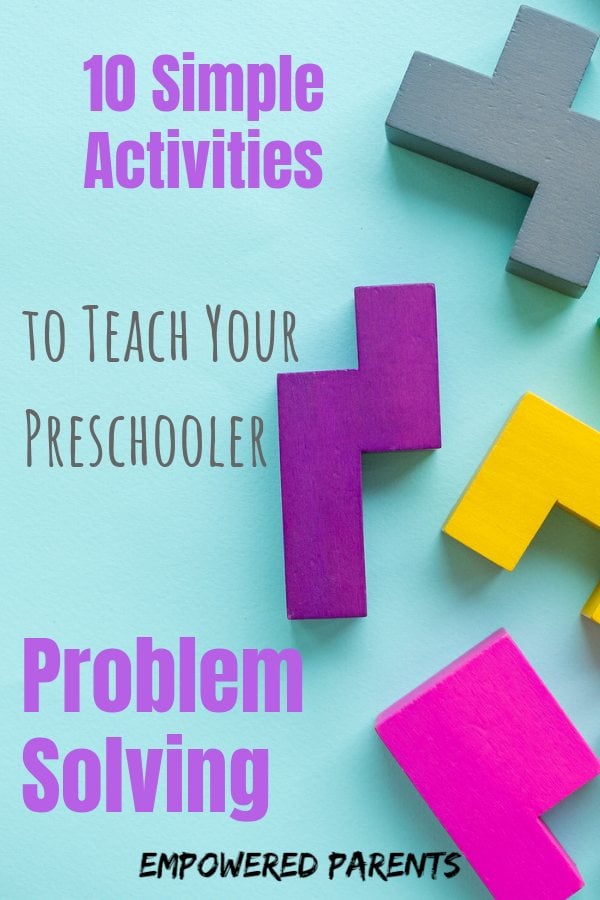
During the first years of a child’s life, an important set of cognitive skills known as problem-solving abilities are developed. These skills are used throughout childhood and into adulthood.
Find out what problem solving is, why it’s important and how you can develop these skills with 10 problem-solving games and activities.
What is Problem Solving in Early Childhood?
So, what exactly is problem solving? Quite simply, it refers to the process of finding a solution to a problem .
A person uses their own knowledge and experience, as well as the information at hand to try and reach a solution. Problem solving is therefore about the thought processes involved in finding a solution.
This could be as complex as an adult working out how to get out of a financial crisis or as simple as a child working out how two blocks fit together.
Problem Solving Skills for Kids
Problem-solving skills refer to the specific thinking skills a person uses when faced with a challenge. Some problems require the use of many skills, while others are simple and may only require one or two skills.
These are some examples of problem-solving skills for preschoolers , as listed by kent.ac.uk .
- Lateral thinking
- Analytical thinking
- Decision-making skills
- Logical reasoning
- Persistence
- Communication skills
- Negotiation skills
The Importance of Developing Problem-Solving Skills in Early Childhood
Problem solving is a skill that would be difficult to suddenly develop as an adult. While you can still improve a skill at any age, the majority of learning occurs during the early years.
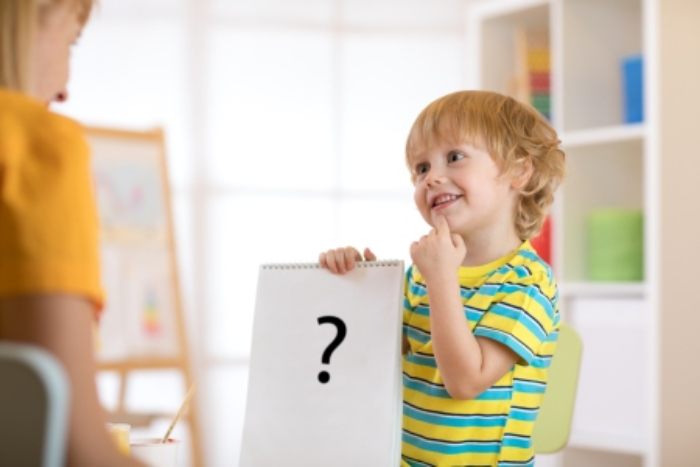
Preschool is the best time for a child to learn to problem solve in a fun way. The benefits of learning early will last a lifetime and the beauty of learning anything at a young age is that it is effortless .
It is like learning to play an instrument or picking up a new language – it’s just much easier and more natural at an early age.
Of all the many things preschoolers need to learn , what makes problem solving so important?
There aren’t many situations in life, at work or at school that don’t require some level of problem resolution.
Child’s play itself is filled with opportunity upon opportunity to solve all kinds of tricky situations and come up with solutions to challenges.
Problem Solving in Preschool
During the foundational years, children are constantly solving problems as they play .
Here are just a few examples of problem solving in early childhood :
- Resolving a fight over the same toy
- Reaching a ball that’s stuck in the tree
- Forming a circle while holding hands
- Making a bridge to connect two block towers
- Tying or untying a shoe
- Making up rules for a new game
- Trying to get the consistency of a mud cake right so it stops falling over
The more creative play opportunities and challenges children are given, the more they get to exercise their problem-solving muscles.
During free play , there are non-stop experiences for this, and parents and teachers can also encourage specific problem-solving skills through guided activities .
Problem Solving for Older Children
During the grades, children experience problems in many forms, some of which may be related to their academic, social and emotional well-being at school. Problems may come in the form of dealing with life issues, such as:
- Problems with friendships
- Struggling to understand something during a lesson
- Learning to balance the demands of sport and homework
- Finding the best way to study for a test
- Asking a teacher for help when needed
Problems will also form a large part of academic life as teachers will be actively developing this skill through various activities, for example:
- Solving a riddle or understanding a work of literature
- Working on projects with a friend
- Finding solutions during science experiments
- Solving mathematical problems
- Solving hypothetical problems during lessons
- Answering questions and completing exam papers
Children who have had practice during preschool will be a lot more capable when facing these challenges.
Solving Problems in Mathematics
Mathematics needs to be mentioned separately as although it is part of schooling, it is such a huge part and it depends heavily on a child’s ability to solve problems.
The entire subject of mathematics is based on solving problems. Whether you are adding 2 and 3, working out how many eggs will fit into each basket, or solving an algebraic expression, there is a problem in every question.
Mathematics is just a series of problems that need to be solved.
What we refer to as problem solving in Maths is usually answering word problems .
The reason many children find these so difficult to answer is that the question is presented as a problem through a story, rather than just numbers with symbols telling you what operation to use (addition, division, etc.)
This means a child is forced to think carefully, understand the problem and determine the best way to solve it.
These problems can involve various units (e.g. mass, capacity or currency) as well as fractions, decimals, equations and angles, to name a few. Problems tend to become more and more complex over the years.
My experience in the classroom has shown that many, many children struggle with solving word problems, from the early grades right into the senior years.
They struggle to analyze the question, understand it, determine what information they’ve been given, and what exactly they are required to solve.
The good news is that exposing a child to regular problem-solving activities and games in preschool can greatly help him to solve word problems later on in school.
If you need one good reason to do these kinds of activities, let it be for a smoother experience in mathematics – a subject so many children unnecessarily fear.
Problem Solving in the Workplace

Adults in the workplace seldom thrive without problem-solving skills. They are required to regularly solve problems .
As adults, employees are expected to independently deal with the frequent challenges, setbacks and problems that are a big part of every working environment.
Those who can face and solve their own problems will go further and cope better than those who seek constant help from others or cannot show initiative.
Some career websites even refer to problem solving as a universal job skill. They also mention that many employees are not good at it.
Again, although it may seem far removed, learning this skill at a young age will help a child cope right into adulthood and in the working world.

How to Teach Children Problem-Solving Skills
If early childhood is the best time to grow these skills in your young children, then how does one go about teaching them to toddlers, preschoolers and kindergarteners?
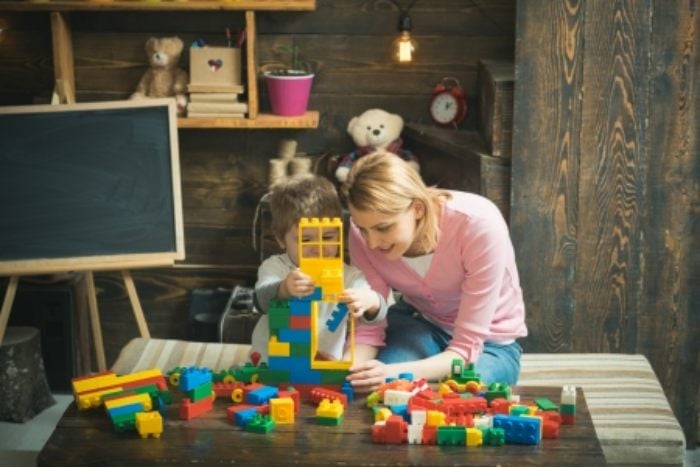
Problem solving can be taught in such a way that you expose your child to various opportunities where they will be faced with challenges.
You would not necessarily sit your 3-year-old down and tell or “teach” him all about fixing problems. Instead, you want to create opportunities for your child to grow this skill .
Using the brain to think and find solutions is a bit like working a muscle over time. Eventually, your muscle gets stronger and can handle more “ weight. ” Your child will learn to problem solve in two ways:
- Incidentally – through free play
- Through guided opportunities provided by a parent or teacher
If you make a point of encouraging thinking through games and activities, your child will develop stronger skills than if you let it all happen incidentally.
Problem-Solving Strategies and Steps
If we take a look at the steps involved in solving a problem, we can see that there are many layers involved and different types of skills. Here are the problem-solving steps according to the University of Ken.
Step 1: Identify the problem
Step 2: Define the problem
Step 3: Examine the options
Step 4: Act on a plan
Step 5: Look at the consequences
Therefore, activities at a preschool level need not present complicated high-level problems.
- A simple activity such as identifying differences in a picture can work on the first skill needed – identifying a problem.
- Playing with construction toys can develop a child’s ability to try various solutions and examine the options when faced with a problem such as trying to find the best way to build something.
- Playing Tic-Tac-Toe would make a child predict the consequences of placing their mark in a particular square.
The most basic of activities can work on all these skills and make children competent solution finders.
How to Teach Problem Solving with Questions
The language you use around your child and your questioning technique will also greatly affect their understanding of a problem or challenge as merely something waiting for a solution to be found .
While your child is playing or when she comes to you with a problem, ask open-ended questions that will guide her in finding a potential answer independently. Use the steps listed above to formulate your questions.
Here are some examples of questions:
- What do you think made the tower of blocks fall down?
- If we build it again, how can we change the structure so that it won’t fall down next time?
- Is there a better way we can do it? If you think of a different way, we can both try it and see which works better.
- Did that work? The tower fell again so let’s try another solution.
Resist the temptation to fix every one of your child’s problems, including conflict with friends or siblings. These are important opportunities for children to learn how to resolve things by negotiating, thinking and reasoning.
With time, your child will get used to seeing a problem, understanding it, weighing up the options, taking action and evaluating the consequences.
Problems will be seen as challenges to be faced logically and not “problems.”
This post contains affiliate links for educational products that I personally recommend. If you purchase through one of them, I earn a commission at no extra cost to you. Read the terms and conditions for more details.
10 Problem-Solving Activities for Preschoolers
Here are 10 simple, easy games and problem solving activities for kids at home or at school. Many of them are the kinds of activities children should have daily exposure to.
Puzzles are one of the best thinking activities out there. Each puzzle is basically one big set of muddled-up things to be sorted out and put back together again. Find out why puzzles are important for development .
Children should have regular exposure to puzzles. They are great for developing thinking skills.
- 4 FUN PET-THEMED PUZZLES: The Melissa & Doug Pets Jigsaw Puzzles include four 12-piece puzzles featuring a...
- STURDY WOODEN STORAGE BOX: Our pets puzzles for kids can be easily stored in the included sturdy wooden...
2. Memory games
Memory games will develop your child’s memory and attention to detail.
Get your own memory game cards by downloading the FREE set of printables at the end of the post.
Use pairs of matching pictures and turn them all face down, shuffled, on a table. Take turns choosing any two cards and turning them face up on the table. If you turn over a matching pair you keep the cards and if the pair doesn’t match, turn the cards back over until it is your turn to try again.
Encourage your child to concentrate and pay attention to where the pictures are and try to find a matching pair on each turn.
3. Building with Construction Toys
Construction toys such as engineering blocks, a proper set of wooden blocks or Legos (shown below) should be a daily staple in your home.
Everything your child builds is a challenge because it requires thinking about what to build and how to put the pieces together to get a design that works and is functional.
Leave your child to construct freely and occasionally set a challenge and ask him to build a specific structure, with conditions. For example:
- Make two towers with a bridge joining them together
- Build a creature that stands on its own and has 3 arms.
Then watch your child wracking his brain until he finds a way to make his structure work.

- STIMULATE CREATIVITY & IMAGINATION: Kids building toy are designed as 110 piece including the 6 building...
- LEARNING BY PLAYING: The STEM building blocks Kit would help to develop the imagination and creativity which...

- Hours of educational fun: The Melissa & Doug wooden building blocks set includes 100 durable wooden blocks in...

- Features a wide range of bricks in 29 different colors, Special pieces include 2 different sets of eyes,...
- Special pieces encourage imaginative building with endless possibilities
4. Activity Books
These activity books are really fun and develop a child’s ability to identify problems and search for information.
- Pomaska, Anna (Author)
- English (Publication Language)
- Handford, Martin (Author)

- Books, Webber (Author)
5. Following Patterns
This simple activity can be played with a set of coloured blocks, shapes or counters.
Simply make a pattern with the blocks and ask your child to continue it. Vary the pattern by changing the colours, shapes or sizes.
This activity will train your child to analyse the given information, make sense of it, recognise the pattern and re-create it.
6. Story Time Questions
Get into the habit of asking questions during your daily story time that develop higher-order thinking skills . Instead of just reading and your child passively listening, ask questions throughout, concentrating on solving problems.
Here are some examples:
- Why do you think the bear did that?
- Do you think his friend will be happy? Why?
- What would you do if you were the monkey?
- How do you think Peter can make things better with his friend?
- If the crocodile had decided not to eat the rabbit, how could the story have ended?
7. Board Games
Board games are an excellent way to develop problem-solving skills.
Start off with simple games like Ludo and Snakes and Ladders to teach the skill of following rules and moving in a logical sequence.
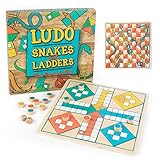
- Double-Header: Enjoy two classic games in Ludo and Snakes and Ladders on this double-faced game board
- Old Classic For A New Generation: Share timeless family games with a new generation of fun, dice rolling...
Card games like Go Fish are also great for teaching young children to think ahead and solve problems.

- KIDS CARD GAMES: Unleash ultimate fun with our Hoyle 6-in-1 Kids Playing Cards Multi Game Pack. Each set...
- GROWTH THROUGH PLAY: Help your children blossom with our social skills games for kids. Each of our games...
8. Tic-Tac-Toe
This is a perfect game to teach decision-making skills , thinking before acting and weighing up the possible consequences.

Use a Tic Tac Toe Board or d raw a simple table like the one above on paper or a chalkboard.

- Wooden tic-tac-toe game board with eye-catching red, orange, blue, and green color pattern
- Includes white-framed wooden board with indented squares for mess-free play, 10 colored x and O game tiles,...
Take turns to add a nought or a cross to the table and see who can make a row of three first.
Your child will probably catch on in no time and start thinking carefully before placing their symbol. This game can also be played with coloured counters or different objects.
9. Classifying and Grouping Activities
This activity can be done with a tin of buttons or beads or even by unpacking the dishwasher. The idea is to teach the skill of classifying and categorizing information by learning with physical objects. Here are some other ideas for categorizing:
- Separate the washing – mom’s clothes, dad’s clothes, etc; or socks, tops, shorts, etc.
- Empty out the cutlery drawer for cleaning, mix all the utensils up and then sort into knives, tablespoons, teaspoons, etc.
- Classify and sort out the toys in your child’s bedroom together – all books, construction toys, soft toys, etc.
- Play category games .
Here are more button activities for kids .
10. Building a Maze
This activity is lots of fun and suitable for any age. It is also going to be way more fun than doing a maze in an activity book, especially for younger children.
Draw a big maze on the paving with sidewalk chalk . Make passages, including one or two that end in a dead-end. Teach your child to find her way out .

- Non-Toxic Formula: Our sidewalk chalk is specially formulated to minimize chalk dust and is safe for indoor...
- Convenient Packaging: Comes in a 20-piece plastic bucket with a lid and handle for easy transport and storage.
As your child gets better at figuring out a route and finding the way out, make the maze more complex and add more dead-end passages.
Are you a preschool teacher or working in Early Childhood Education? Would you like to receive regular emails with useful tips and play-based activity ideas to try with your children? Sign up for the newsletter!
This site uses Akismet to reduce spam. Learn how your comment data is processed .
Friday 3rd of June 2022
hi maam , This Is Uma from India,Can i get this in pdf format or a book. Thank You
Tanja Mcilroy
Monday 6th of June 2022
Hi Uma, thanks for your message. These articles are not available in PDF, but you are welcome to copy and paste them from the website, as long as you add the reference: https://empoweredparents.co/problem-solving-activities-preschoolers/ Thanks for reading!
Wednesday 20th of May 2020
Very very useful content. Good work. Thank you.
Friday 22nd of May 2020
Thanks Ann.
Tuesday 19th of May 2020
Would like to download the free activity pack please.
Hi Kelly, Please download the activity pack on this page: www.empoweredparents.co
Social Problem Solving Task Cards & Journal Prompts - Free SEL Skill Activities

- Google Apps™
Description
These are a set of 10 free task cards that highlight social scenarios and situations that kids can discuss and identify how they would solve each situation. The cards are organized into five different sets that target different situations: With friends, with family, in the classroom, at recess, and at lunch. This free set includes 2 task cards from each set.
Digital Version
I've included a FREE digital version with prompts for students to answer! Just follow the link to access the Google Drive copy.
These cards are great for students with social difficulties and those who are rigid and might get "stuck" in their way of thinking. Use these task cards to allow students to discuss a variety of social situations and brainstorm for the best solutions to problems. This includes students with autism, ADHD, oppositional defiant disorder, and more.
Encourage Making Positive Choices
These task cards ultimately encourage making positive choices by thinking through social problems, considering options, and then determining the best choice to make. They are great discussion starters for groups.
How to Use the Task Cards
The task cards can be used in guided small groups, as part of class discussions, or in partner discussion before sharing out with the larger group or class. Regular education teachers, special education teachers, and other support professionals could all benefit from using these task cards with their students.
Buy the Whole Set for Elementary Kids
— { Social Scenario Problem Solving Task Cards }
This is a pack of over 100 fun task cards that highlight social scenarios and situations that kids can discuss and identify how they would solve each situation. The cards are organized into five different sets that target different situations: With friends, with family, in the classroom, at recess, and at lunch.
Buy the Whole Set for Middle and High School Kids
— { Social Scenario Problem Solving Task Cards for Middle and High School }
This is a pack of 100 task cards that highlight social scenarios and situations that kids can discuss and identify how they would solve each situation. The social situation cards are organized into five different sets that target different situations: With friends, with family, in classes, in the hallway and cafeteria, and online and texting.
*****************************************************************************
Tips for Customers!
{ Click here to follow my store! }
If you have questions or problems please contact me through Product Q & A and I'll get back to you as soon as I can!
Disclaimer: These resources and materials are for supplementary support/education purposes and not intended as a replacement for counseling, education, or other necessary supports. Educators, parents, counselors, and others who utilize these materials are encouraged to seek out additional support, as needed.
Questions & Answers
Pathway 2 success.
- We're hiring
- Help & FAQ
- Privacy policy
- Student privacy
- Terms of service
- Tell us what you think

IMAGES
VIDEO
COMMENTS
Preschool and kindergarten problem solving activities give children an opportunity to use skills they have learned previously and give you an opening to teach new problem solving strategies. Introduce the vocabulary of solving problems with stories, puppets and everyday situations that occur. "We only have 10 apples but there are 20 students.
Children will have to follow the clues and solve puzzles to find the ultimate prize. This activity encourages problem-solving, critical thinking, and teamwork. 7. Scavenger Hunt. Playing Scavenger Hunt can be a fun way for our kids to put their creative problem-solving skills to good use.
Home practice will make progress toward meeting individual language goals much faster. Speech-Language Pathologists (SLPs) are only able to see students/clients 30-60 mins (or less) per week. This is not enough time or practice for someone to handle Problem solving scenarios. Every day that your loved one goes without practice it becomes more ...
4. The Penny Drop Challenge. This activity was selected because it requires kids to think about physics and how different materials affect sound. To do this activity, you will need a penny ( or another coin), a cup, and various materials such as paper towels, cotton balls, etc.
By honing their problem-solving abilities, we're preparing kids to face the unforeseen challenges of the world outside. Enhances Cognitive Growth: Otherwise known as cognitive development. Problem-solving isn't just about finding solutions. It's about thinking critically, analyzing situations, and making decisions.
Young children learn social problem-solving skills like learning to share and asking for preferred items. They learn to use the right words, tone of voice, and body language. They also learn to read the body language and tone of voice of others. They learn to make social inferences and understand the perspectives of others.
2) Verbalize the problem. Once your child is calm, ask him or her to verbalize the problem he or she is struggling with. Putting our thoughts into words can help us gain perspective and make it easier for us to search for solutions. 3) Brainstorm solutions.
KINDERGARTEN MATH PROBLEM SOLVING FOR THE FIRST NINE WEEKS -- $6. In this package, students learn HOW to problem-solve--how to use their notebooks and math tools; how to share their thinking; and how to record their solutions. They also practice counting, explore 2-D shapes and do some beginning addition and subtraction.
But before you do that, here are 5 kindergarten problem solving activities for kids that will make you feel a little better about keeping them around… at least for a little bit longer. 1. Free Building Play. So after I resist the urge to whip into a crazy, toy-trashing whirlwind come across toys the kids have left out, I put them in a ...
Here are a few tips for how to teach problem solving in kindergarten. 1. Focus on Common Kindergarten Problems. When people think of solving problems in kindergarten, they often focus on conflict resolution between students. However, in kindergarten, there can be a wide range of challenges that students experience during the day.
Explicitly teaching problem-solving skills to your students will have multiple benefits: easier classroom management, improved social-emotional learning, better self-regulation skills, and so much more. Finding the time and the resources to do it, though, can be tricky. My problem-solving task cards are here to help!
71+ Social Problem Scenarios + 6 Blank Scenarios. Use the 71 social problem-solving scenarios to have your students get great experience practicing how to solve a social problem. Also, included are 6 blank scenarios. Then laminate them so you can use them over and over again. Therefore, create social problems that the student experiences and ...
Browse free kindergarten problem solving worksheets on Teachers Pay Teachers, a marketplace trusted by millions of teachers for original educational resources. Log In Join. Cart is empty. Total: ... Alphabet Activities Bundle - Letter Recognition & Beginning Sounds Centers. Fun Learning for Kids. $25.00 Price $25.00 $48.00 Original Price $48.00.
• Problem Solving • Suggesting play themes and activities to peers • Sharing toys and other materials • Taking turns • Helping adults and peers • Giving compliments • Understanding how and when to apologize • Expressing empathy with others' feelings • Understanding appropriate ways to express anger • Learning how to calm down
5. Shape Sudoku. Sudoku is an interesting Japanese puzzle where the player is required to fill empty places in a grid with numbers, making sure no number is repeated in a row or column. Shape Sudoku replaces numbers with shapes, to make it more fun for kindergarteners, and is a great way to improve your little one's problem solving skills.
Problem Solving and Innovating - "Learning to think creatively, analytically and critically is important in all aspects of life. Children are naturally curious. ... Activities. At Home Play-Doh. This at home play-doh recipe is a great way to teach children how to create their own play-doh. Play-doh is a fun material for your children to use ...
Our problem solving SEL unit includes reading, writing, and art activities. Skills Related to Problem Solving. Problem-solving, in the context of social emotional learning (SEL) or character education, refers to the process of identifying, analyzing, and resolving challenges or obstacles in a thoughtful and effective manner.
Meal prep interactive problem solving boom cards with audio guidance. Created by. learnplayrepeat. Nutrition theme learning activities for preschool/ kindergarten ageLearn social and life skills with this fun and engaging interactive game! Perfect for group or independent activities and can be used face to face or for distance learning.
A fun, hands-on center or activity to do with your preschool, kindergarten or primary students. This activity addresses various critical thinking and problem solving skills. Children are also learning how to not only identify, but build basic shapes as well.This pack contains:★ "I Can" poster for center (directions for students)★ Two pages of pattern cards (8 shapes to build)★ Recording ...
Description. REVISED: Reformatted to be printer friendly :) Check out this pragmatic language resource. It can be used for instruction, reinforcement, or as an assessment. Resource includes: * 28 Scenario Cards. * 4 Lose a Turn Cards. * 4 Gain a Turn Cards. * Problem Solving Assessment Checklist.
If we take a look at the steps involved in solving a problem, we can see that there are many layers involved and different types of skills. Here are the problem-solving steps according to the University of Ken. Step 1: Identify the problem. Step 2: Define the problem. Step 3: Examine the options.
These are a set of 10 free task cards that highlight social scenarios and situations that kids can discuss and identify how they would solve each situation. The cards are organized into five different sets that target different situations: With friends, with family, in the classroom, at recess, and at lunch. This free set includes 2 task cards ...